
about me
Anyone who knows me is aware that I am a bit of a movie buff. Over the past few years I have been building an autograph collection of my favourite actors’ signed photographs. Since I like movies so much there are many actors whose work I enjoy. I have collected the photographs from the actors themselves, through contacts in the studios and through auctions. I now have over 2,000 photographs in the collection.
My Autograph Collection
I have separated my autograph collection into different categories, which you can see below. Feel free to browse whichever section interests you. Inside, I share not only the autographed photo in my possession, but also information about the actor, including their biography, photos and posters of their movies, and sometimes videos dedicated to them.
Whether you’re drawn to classic Hollywood icons, contemporary superstars, or character actors with a cult following, there’s something in my autograph collection for every movie enthusiast. If you enjoy my blog, don’t hesitate to leave a comment on one of my entries.
Actors Autograph Collections
Blog Categories
BRITISH ACTORS
Collection of Classic Brittish Actors
IRISH ACTORS
Collection of Classic Irish Actors
HOLLYWOOD ACTORS
Collection of Classic Hollywood Actors
EUROPEAN ACTORS
Collection of Classic European Actors
CONTEMPORARY ACTORS
Collection of Classic Contemporary Actors
RECENT POSTS
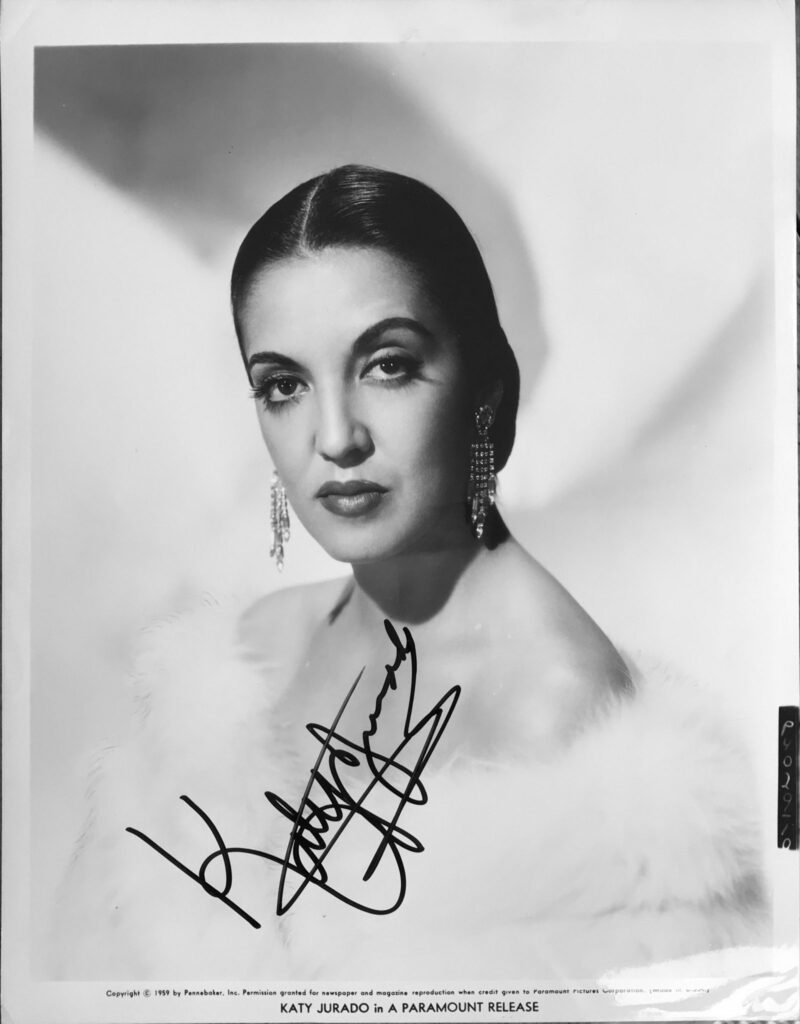
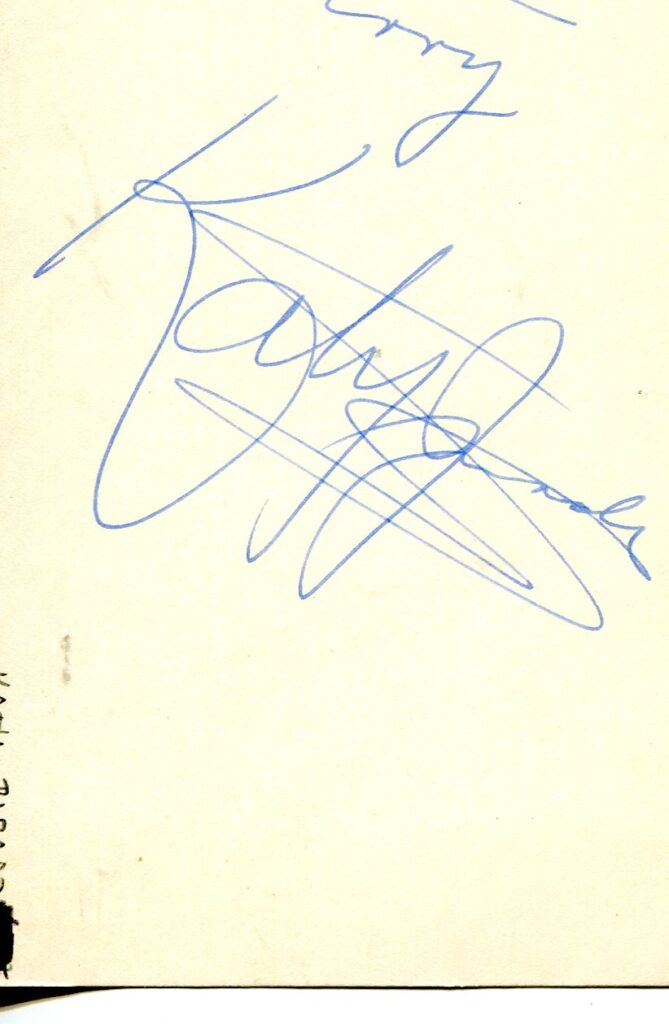
KATY JURADO OBITUARY IN “THE GUARDIAN” IN 2002.
Katy Jurado who has died at the age of 78, was one of the Latina actors who hit Hollywood long before the contemporary generation, for whom, along with the likes of Dolores del Rio, she helped pave the way. Unlike Del Rio or Maria Felix, she was not a classic beauty, but her enormous eyes and body language quietly signalled powerful sexuality and a strength of character, the latter particularly significant in her US films.
Her family was extremely wealthy: indeed, generations before, they had owned the whole of what is now Texas. Come the Mexican revolution, they lost it, and, as Jurado remarked ironically: “My family is no longer very, very rich, but they still live that way.” Her father was a cattle rancher and owner of orange groves; her mother, a former opera singer who had retired from the stage to marry.
In 1943, to the dismay of her family Jurado was signed up to appear in Internado Para Señoritas, directed by Gilberto Martínez Solares, for which she won an Ariel (Mexico’s Oscars). There was then a spate of 13 films before she made her American debut, as the wife of Gilbert Roland in Bud Boetticher’s The Bullfighter And The Lady (1951), shot in Mexico.
Jurado appeared in three more Mexican movies, including a great performance in Luis Buñuel’s El Bruto (1952) – for which she won the top Mexican award – before going to Hollywood the same year to play in Fred Zinneman’s High Noon.
Reportedly not knowing any English, during the shoot of both her early US films she learnt her lines phonetically, had them explained in Spanish and “hoped for the best”. This seems difficult to believe, especially when you see her performance in High Noon, for which she was Oscar-nominated as best supporting actress, so it may have been a publicity stunt.
Whatever the truth, Jurado continued to make US films until the early 1960s, appearing in such productions as Arrowhead (1953), with Charlton Heston, and Broken Lance (1954), as Spencer Tracy’s Indian wife. She took over this role from Dolores del Rio, who was refused a work permit for having contributed to a cause considered communist in the US.AJurado won an Oscar for best supporting actress in Broken Lance, though, in some ways, it is difficult to see why. For most of the film, she does little except play sounding board for Tracy – although she does it well. She only comes into her own at the end, when her performance is short but emotionally powerful. She was heavily made-up to add to her years.
Other films included Trapeze (1956), with Burt Lancaster, and One-Eyed Jacks (1959), with Marlon Brando, before she returned to make films in Mexico. Her later US work included Pat Garrett And Billy The Kid (1973), John Huston’s Under The Volcano (1984) and Stephen Frears’s Hi-Lo Country (1998), in which her appearance lasted hardly longer than her name on the credits, although her presence was as immediate and powerful as ever
She made guest appearances in US television series such as Alias Smith And Jones and The Virginian, continued to work in Mexico, and appeared consistently on Mexican television from the 1970s. She won many awards at home, and is the only Mexican woman to have received the keys to New York City, in 1954.
But film was not Jurado’s only profession: she wrote features, film reviews and, as an authority on bullfighting, for Mexican newspapers. She was also a radio commentator.
She was married at a young age to Victor Velasquez, the Mexican film actor and writer, by whom she had a son and a daughter; in 1959 she married the actor Ernest Borgnine, from whom she was divorced after five years.
· Maria Cristina Estella Marcela Jurado García, actor and writer, born January 16 1924; died July 5 2002
- Liam
- No Comments
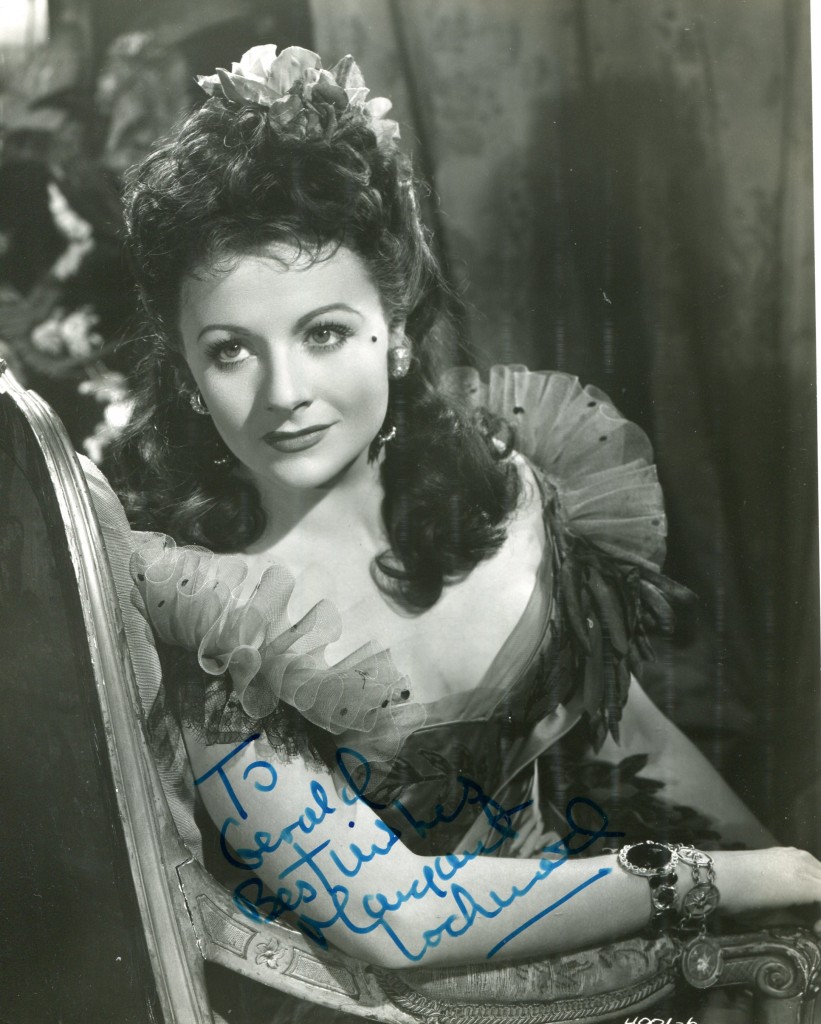
Margaret Lockwood was not by any means a great screen actress, but she was spirited and likeable. The British public queued to see her until blatant mishandling ruined her career. Possibly (age apart) she might not have retained her popularity. There was something about her South-London-bred personality that suited the 40’s and by the mid-50’s she and her fellows – Phyllis Calvert, Patricia Roc and Jean Kent were passe as far as the cinema was concerned. One can only speculate as to what they might have been like had they ever had good scripts or first-rate directors, though Milton Shulman in the ‘Evening Stand’ in 1946 had little doubt; in an open letter to Mr Rank he claimed that he could find five girls as pretty and talented as this bunch by watching the secretaries get off the escalators in Leicester Square Station. He could’nt, of course” – David Shipman – “The Great Movie Stars – The Golden Years”. (1970).
MARGARET LOCKWOOD GUARDIAN TRIBUTE
Margaret Lockwood was the most popular actress in British films in the 1940’s. She was bron in 1916 in Karachi, Pakistan. She began her film career in 1934 and the following year she had a major role in “Lorna Doone”. In 1938 she starred in the Alfred Hitchcock classic “The Lady Vanishes” and was soon on her way to Hollywood. She made two movies there “Susannah of the Mounties” with Randolph Scott and Shirley Temple and “Rulers of the Sea” with Douglas Fairbanks Jnr. However she was soon back in England and her career went from strength to strength. Her major movies include “The Stars Look Down” in 1939, “Night Train to Munich” “The Man in Gray” , “The Wicked Lady” in 1945, “Love Story”, “Madness of the Heart” and ” Cast a Dark Shadow”. In 1971 she won critical acclaim for her television performances in the series “Justice”. She died in 1990. Her daughter is the actress Julia Lockwood.
Philip French’s excellent article on Lockwood in the Guardian:
She was born in India, a daughter of the Raj, brought up in England by a cold, domineering mother, and was an experienced child actor before studying at Rada. Playing costume heroines, career girls and socialites, this brunette beauty became a sort of movie star in Carol Reed’s debut Midshipman Easy (1935), the first of seven collaborations with Reed, and a real star as the bored heiress in Hitchcock’s comedy-thriller The Lady Vanishes (1938). This brought her to Hollywood’s attention. But after two unsuccessful films there in 1939, she returned home for good to become the greatest British star of the 1940s, starting with Reed’s The Stars Look Down as the upper-middle-class wife of working-class Michael Redgrave.
This unsympathetic role was the first of numerous seductive femmes fatales, mostly with James Mason, Phyllis Calvert, Stewart Granger and Patricia Roc. The most famous was her Lady Barbara Skelton, the aristocrat moonlighting as an 18th-century highwayman in The Wicked Lady (1945). She caused problems for the Hollywood Production Code with her provocative cleavage. A 1948 editorial in the polemical magazine Sequence, co-edited by Lindsay Anderson, sarcastically noted: ‘Mr Harold Wilson was recently recorded … presenting Miss Margaret Lockwood with a heavy, silver-plated ornament, thus bestowing official sanction on to the British people’s judgment that Miss Lockwood is their finest actress. Indeed, as Mr Wilson smilingly remarked, this comes to the same thing as saying: “The finest actress in the world.”‘
Her film career went downhill following her appeal to J Arthur Rank that she was ‘sick of sinning’. She refused the title role in Forever Amber but sunnier parts proved unpopular, especially her jolly Nell Gwynne in Cardboard Cavalier. Joining the company run by Herbert Wilcox, husband of her rival, Anna Neagle, she fared no better, and gave up films to enjoy much success in the theatre (she was an excellent Eliza in Pygmalion) and on TV. She made an impressive comeback as a barmaid in Lewis Gilbert’s Cast a Dark Shadow (1955), and after an absence of 20 years played the evil stepmother in Bryan Forbes’s The Slipper and the Rose (1976). Her reclusive life was interrupted by a visit to Buckingham Palace on being made a CBE in 1980.
Philip French’s article in The Guardian can also be accessed on-line here.
“The Times” obituary:
Margaret Mary Lockwood, the daughter of an English administrator of an Indian railway company, by his Scottish third wife, was born in Karachi, where she lived for the first three and a half years of her life. In 1920, she and her brother, Lyn, came to England with their mother to settle in the south London suburb of Upper Norwood, and Margaret enrolled as a pupil at Sydenham High School. Her childhood was repressed and unhappy, largely due to the character of her mother, a dominant and possessive woman who was often cruelly discouraging to her shy, sensitive daughter. As a result, Margaret took refuge in a world of make-believe and dreamed of becoming a great star of musical comedy. After becoming a dance pupil at the Italia Conti school. she made her stage debut at 15 as a fairy in ” A Midsummer Night’s Dream” at the Holborn Empire. A year later, she played another fairy, for 30 shillings a week, in “Babes in the Wood” at the Scala Theatre. The excitement of “walking on” in Noel Coward’s mamouth spectacular, “Cavalcade”, at Drury Lane in 1931 came to an abrupt conclusion when her mother removed her from the production after learning that a chorus boy had uttered a forbidden four-letter expletive in front of her.
In 1933, she enrolled at the Royal Academy of Dramatic Art, where she was seen in Leontine Sagan’s production of “Hannele” by a leading London agent, Herbert de Leon, who at once signed her as a client and arranged a screen test which impressed the director, Basil Dean, into giving her the second lead in his film, “Lorna Doone” when Dorothy Hyson fell ill. Seven ingenue screen roles followed before she played opposite Maurice Chevalier in the 1936 remake of “The Beloved Vagabond”. A year later, she married a man of whom her mother disapproved strongly, so much so that for six months Margaret Lockwood did not live with her husband and was afraid to tell her mother that the marriage had taken place. In 1938, Lockwood’s role as a young London nurse in Carol Reed’s film, “Bank Holiday”, established her as a star, and the enormous success of her next film, “The Lady Vanishes“, opposite Michael Redgrave, gave her international status
visit to Hollywood to appear with Shirley Temple in “Susannah of the Mounties” and with Douglas Fairbanks Jr in “Rulers of the Sea” was not at all to her liking. She returned with relief to Britain to star in two of Carol Reed’s best films, “The Stars Look Down”, again with Redgrave, and “Night Train to Munich“, opposite Rex Harrison. In 1941, she gave birth to a daughter by Leon, Julia Lockwood, affectionately known to her mother as “Toots”, who was also to become a successful actress. The Leons separated soon after her birth and were divorced in 1950. Lockwood gained custody of her daughter, but not before Mrs Lockwood had sided with her son-in-law to allege that Margaret was “an unfit mother.” The turning point in her career came in 1943, when she was cast opposite James Mason in “The Man in Grey”, as an amoral schemer who steals the husband of her best friend, played by Phyllis Calvert, and then ruthlessly murders her. Spectral in black, with her dark, dramatic looks, cold but beautiful eyes, and vividly overpainted thin lips, Lockwood was queen among villainesses. The film inaugurated a series of hothouse melodramas that came to be known as Gainsborough Gothic and had film fans queueing outside cinemas all over Britain.
In 1944, in “A Place of One’s Own”, she added one further attribute to her armoury: a beauty spot painted high on her left cheek. It became her trade mark and the impudent ornament of her most outragous film “The Wicked Lady”, again opposite Mason, in which she played the ultimate in murderous husband-stealers, Lady Skelton, who amuses herself at night with highway robbery. The amount of cleavage exposed by Lockwood’s Restoration gowns caused consternation to the film censors, and apprehension was in the air before the premiere, attended by Queen Mary, who astounded everyone by thoroughly enjoying it. The film’s worldwide success put Lockwood at the top of Britain’s cinema polls for the next five years.
After poisoning several husbands in “Bedelia” (1946), Lockwood became less wicked in “Hungry Hill”, “Jassy”, and “The White Unicorn”, all opposite Dennis Price. She complained to the head of her studio, J. Arthur Rank, that she was “sick of sinning”, but paradoxically, as her roles grew nicer, her popularity declined. She refused to return to Hollywood to make “Forever Amber”, and unwisely turned down the film of Terence Rattigan’s “The Browning Version”. Her contract with Rank was dissolved in 1950 and a film deal with Herbert Wilcox, who was married to her principal cinema rival, Anna Neagle, resulted in three disappointing flops. In 1955, she gave one of her best performances, as a blowsy ex-barmaid in “Cast a Dark Shadow”, opposite Dirk Bogarde, but her box office appeal had waned and the British cinema suddenly lost interest in her.
An unpretentious woman, who disliked the trappings of stardom and dealt brusquely with adulation, she accepted this change in her fortunes with unconcern, and turned to the stage where she had a success in “Peter Pan”, “Pygmalion”, “Private Lives”, and Agatha Christie’s thriller “Spider’s Web”, which ran for over a year. In 1965, she co-starred with her daughter, Julia, in a popular television series, “The Flying Swan”, and surprised those who felt she had never been a very good actress by giving a superb comedy performance in the West End revival of Oscar Wilde‘s “An Ideal Husband”.
After what she regarded as her mother’s painful betrayal at the custody hearing, the two women never met again, and when a friend complimented Mrs Lockwood on her daughter’s performance in “The Wicked Lady”, she snapped: “That wasn’t acting. That was natural.” Lockwood never remarried, declaring: “I would never stick my head into that noose again,” but she lived for many years with the actor, John Stone, whom she met when they appeared together in the 1959 stage comedy, “And Suddenly It’s Spring”. Stone appeared with her in her award winning 1970s television series, “Justice”, in which she played a woman barrister, but after 17 years together, he left her to marry a theatre wardrobe mistress. This last blow, coupled with the sudden death of her trusted agent, Herbert de Leon, and the onset of a viral ear infection, caused her to turn her back gradually on a glittering career.
She had one last film role, as the stepmother with the sobriquet, “wicked”, omitted but implied, in Bryan Forbes‘s Cinderella musical, “The Slipper and the Rose” in 1976. Her final stage appearance, as Queen Alexandra in “Motherdear”, ran for only six weeks at the Ambassadors’ Theatre in 1980.
That year, she was created CBE, but her appearance at her investiture at Buckingham Palace accompanied by her three grandchildren was her last public appearance. For the remaining years of her life, she was a complete recluse at her home in Kingston upon Thames, rejecting all invitations and offers of work.
In spite of this, she was warmly remembered by the public. When the author Hilton Tims, was preparing his recent biography, “Once a Wicked Lady”, a stall holder from whom he was buying some flowers for her, snatched up a second bunch and said, “Give her these from me. I used to love her films.”
- Liam
- No Comments
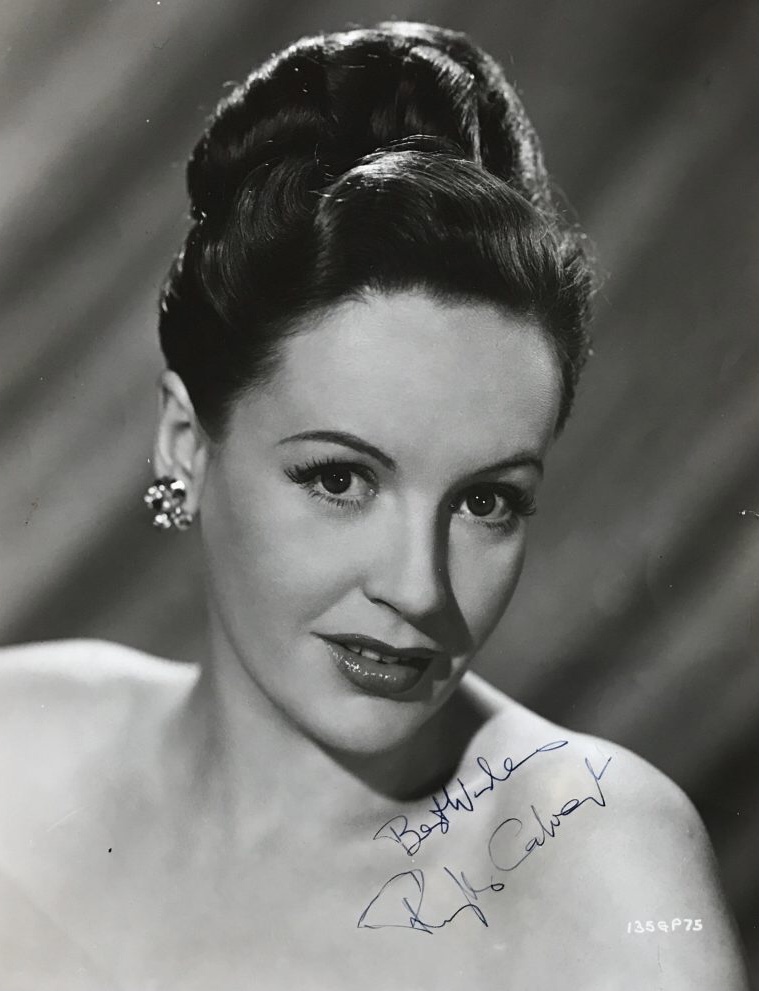
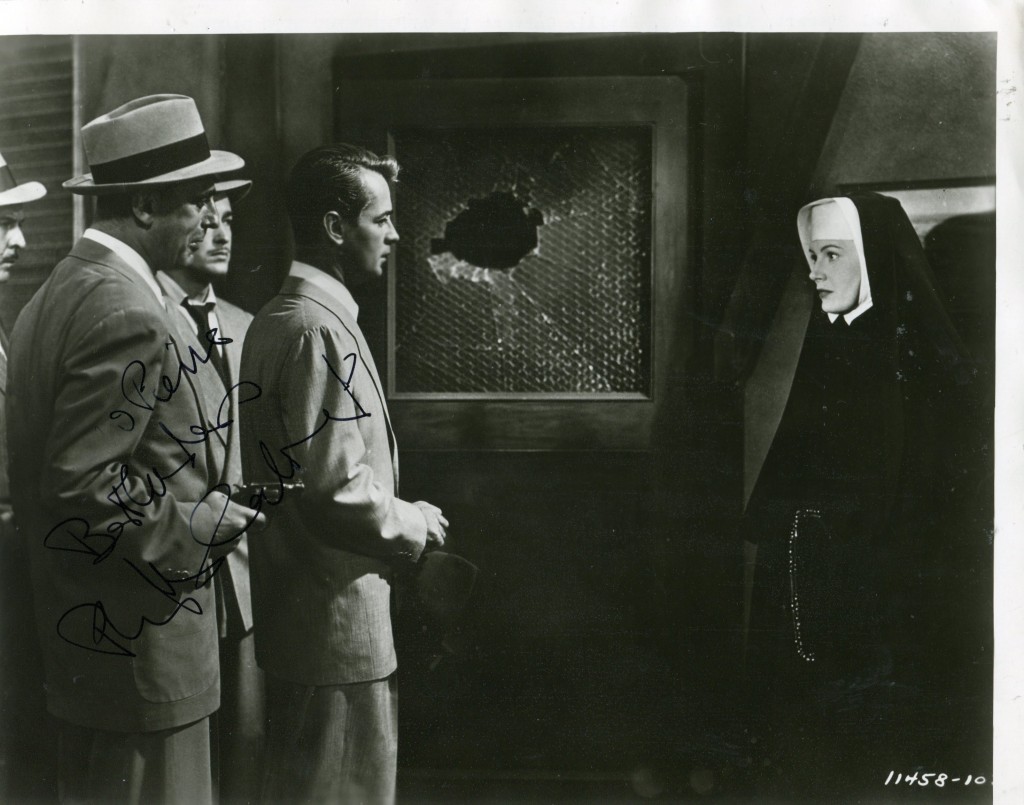
PHYLLIS CALVERT OBITUARY IN “THE GUARDIAN” IN 2002
Phyllis Calvert was one of the Gainsborough ladies who were the leading lights of 40’s cinema in Britain. Margaret Lockwood was the leading light followed coosely in popularity bu Phyllis Calvert and then Patricia Roc and Jean Kent. Ms Calvert was born in Chelsea, London in 1915. She made her London stage debut in “A Woman’s Privilege” in 1939. Her breakthrough role on film came with “The Man in Gray” in 1943. Other film highlights include”2,000 Women”, “Fanny by Gaslight”, “Madonna of the Seven Moons” and “The Magic Bow”. She made three films in Hollywood including “Appointment With Danger” in 1951 with Alan Ladd where she played a nun who witnesses a murder. In 1952 she received widespread critical acclaim for “Mandy”. She continued working well into her eighties. Phyllis Calvert died in 2002 at the age of 87
Eric Shotter’s obituary in “The Guardian” :
Phyllis Calvert, who has died aged 87, made her way to the top of British cinema in the 1940s through niceness. As a well-bred, Kensington-accented cornerstone of Gainsborough costume epics, she vied with Margaret Lockwood at the box office.
Regency romps, they were known as. Utter nonsense, with heart-throbs like Stewart Granger and James Mason served up with grace and charm, was quintessential to Calvert’s artistic durability – but to keep it up, without growing dull, required a determined personality and an exceptional talent. It saw her through a long and respectable career in films, plays and television.
The only great dramatic part that ever came Calvert’s way was Madame Ranevskya in The Cherry Orchard, for the Oxford Playhouse on tour in 1971. Yet, within her permitted range, was a talent which served writers from Terence Rattigan (Flare Path, 1942), JM Barrie (Peter Pan, 1947), Roger MacDougall (Escapade, 1953) and Graham Greene (The Complaisant Lover, 1959), to Noel Coward (Present Laughter, 1965, Blithe Spirit, 1971, Hay Fever, 1973), William Douglas Home (The Reluctant Debutante, 1975), Edward Albee (All Over, 1973), Denis Cannan (Dear Daddy, 1976) and Rodney Ackland (Before The Party, 1980).
Whether as bored wives realising how much their boring husbands need them, long-suffering matriarchs tied to bombastic pacifists or in flight from their rowdy families, or just het up because cook had handed in her notice, Calvert’s galère of gracious British womanhood was hard to take your eyes off. Her sense of comedy never failed her in its dry, sarcastic discipline, and there was always that expressive lower lip, with which she stirred our feelings in the feeblest part
child dancer until an injury forced her to switch to acting, she was born Phyllis Bickle in London, and educated at the Margaret Morris school of dancing and the Institut Français. She first appeared on the stage aged 10, at the Lyric, Hammersmith, with Ellen Terry in Walter de la Mare’s Crossings (1925). She got her chance in films at 12 and, during six or seven prewar years in weekly rep, made a few forgotten talkies.
In Max Catto’s Punch Without Judy (1939), she met her future husband, Peter Murray Hill, better known later as a publisher. With him as Hook, she also acted Peter Pan in the annual Scala revival of 1947. The golden wartime days at Gainsborough studios, with James Mason or Stewart Granger dancing attendance in such epics as The Man In Grey (1943), Fanny By Gaslight (1944), Madonna Of The Seven Moons (1944) and They Were Sisters (1945) had long gone; though she regularly went on making films of even more variable quality for another quarter of a century.
One of the best of the bunch was probably Mandy (1952), in which Calvert got all our tear-ducts going as the mother of the deaf-and-dumb heroine.
Her work on stage and television – especially as a woman’s page writer in the series Kate, and plays like Death Of A Heart (1985) and Across The Lake (1988) – stood her in better stead because it had the backing of years in rep. It gave her a technique of little use before the camera, but invaluable on stage.
As a parent-turned-novelist in Felicity Doulkas’s It’s Never Too Late (1954), Calvert took over from Celia Johnson. As the Countess in Anouilh’s The Rehearsal (1961), she superciliously condoned her husband’s affair with Maggie Smith’s young Lucile; and, as Mrs Arbuthnot in Wilde’s A Woman Of No Importance (1967), she showed how beans could be spilled with style.
It was, however, as Queen Mary – in succession to Wendy Hiller – that her stage authority rose exquisitely to the social occasion in Royce Ryton’s Crown Matrimonial (1973). Struggling – first, as a mother through the constraints of court behaviour, and, second, as an actor through her natural niceness – to speak to her son, Edward VIII (Peter Barkworth), she brought emotional eloquence to the task of reproaching him for putting personal happiness before the monarchy.
She made her final stage appearance at the Chichester festival in 1989, in Henry James’s The Heiress, when she was 74, and came out of retirement to appear in her last film, Mrs Dalloway, in 1997.
The only other times I recall Calvert risking loss of sympathy for an apparent lapse of taste, grace or charm was at the Lyric in 1963, and at the Duke of York’s in 1964. In the first, as Marius Goring’s wife in Ronald Duncan’s Ménage à Trois, she condoned his misconduct – as long as it took place off the premises, herself departing as a lesbian with his mistress as the curtain fell. Then, as the cold, insensitive stepmother in James Saunders’s A Scent Of Flowers, she left no trace of “the rose that sings”. Was it purely coincidental that neither show ran?
Peter Murray Hill died in 1957. Calvert is survived by her son and a daughter.
· Phyllis Calvert, actor, born February 18 1915; died October 8 2002
- Liam
- No Comments
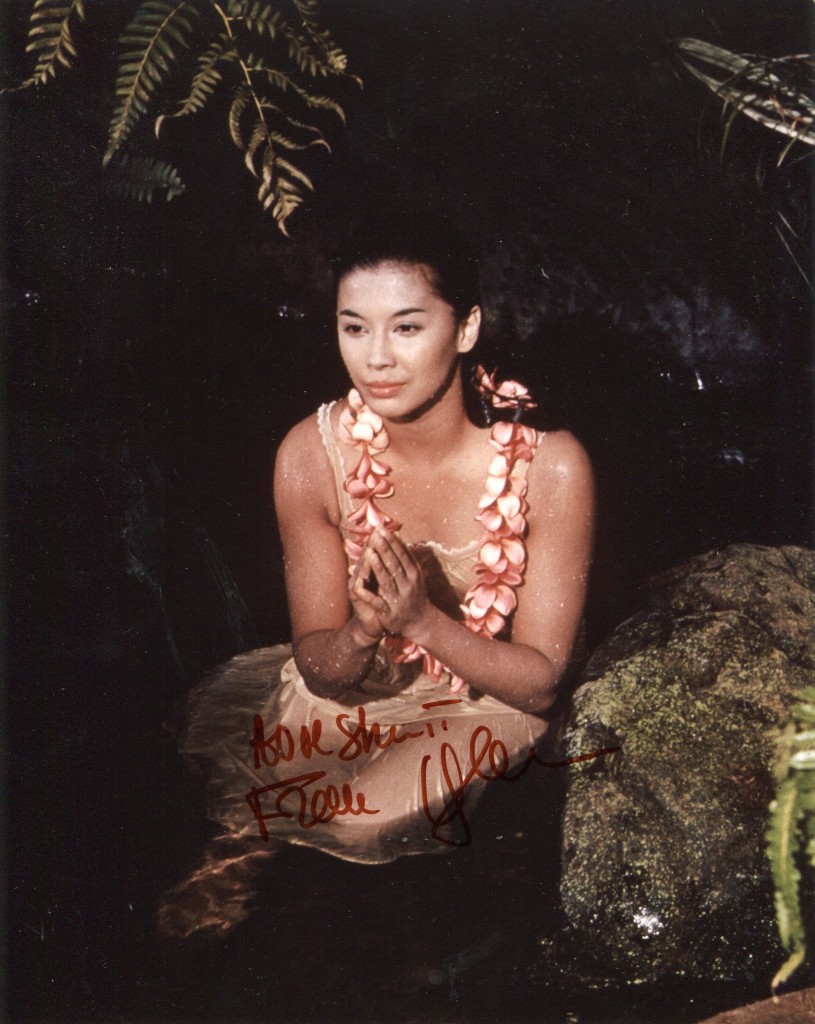
France Nuyen (born France Nguyễn Vân Nga on 31 July 1939) is a French-American actress, model, and psychological counselor. She is known to film audiences for playing romantic leads in South Pacific (1958), Satan Never Sleeps (1962), and A Girl Named Tamiko (also 1962), and for playing Ying-Ying St. Clair in The Joy Luck Club (1993). She also originated the title role in the Broadway play The World of Suzie Wong, based on the novel of the same name. She is a Theatre World Award winner and Golden Globe Award nominee.
France Nuyen was born in Marseille. Her mother was French and during World War II, her mother and grandfather were persecuted by the Nazis for being Roma.
Nuyen was raised in Marseille by a cousin she calls “an Orchidaceae raiser who was the only person who gave a damn about me.” Having left school at the age of 11, she began studying art and became an artist’s model
In 1955, while working as a seamstress, Nuyen was discovered on the beach by Lifephotographer Philippe Halsman. She was featured on the cover of 6 October 1958 issue of Life
France Nuyen became a motion picture actress in 1958. In her first role, she appeared as Liat, daughter of Bloody Mary (played by Juanita Hall) in the Rodgers and Hammerstein musical South Pacific.
In 1978 France Nuyen guest-starred with Peter Falk and Louis Jourdan in the Columbo episode “Murder Under Glass“. In 1986 she joined the cast of St. Elsewhere as Dr. Paulette Kiem, remaining until the series ended in 1988.
Ms Nuyen appeared in several films including The Last Time I Saw Archie (1961) Satan Never Sleeps (1962), A Girl Named Tamiko(1962), Diamond Head (1963), Dimension 5 (1966), Battle for the Planet of the Apes (1973), The Joy Luck Club (1993) and The American Standards (2008).
France Nuyen worked several times with actor William Shatner. At age 19, she was cast in Shatner’s 1958 Broadway play The World of Suzie Wong. The play ran for more than 500 performances and was quite financially successful. Both Nuyen and Shatner later collected notable accolades for their work on the show, at the 1959 Theatre World Awards.
Ms Nuyen worked again with Shatner across three US television projects, starting with “Elaan of Troyius“, a 1968 third season episode of the original Star Trek in which Nuyen was the title character. She would later appear with Shatner in the 1973 made for TV movie The Horror at 37,000 Feet, and afterward in a 1974 episode of the Kung Fu.
France Nuyen was married to Thomas Gaspar Morell, a psychiatrist from New York, by whom she has a daughter, Fleur, who resides in Canada and works as a film make-up artist. She met her second husband, Robert Culp, while appearing in four episodes of his television series I Spy. They married in 1967, but divorced three years later. In 1986, Nuyen earned a master’s degree in clinical psychology and began a second career as a counselor for abused women, children and women in prison. She received a Woman of the Year award in 1989 for her psychology work. In the Life cover story on Nuyen, she is quoted as saying a proverb she also repeated in character as a spy in the I Spy episode “Magic Mirror”: “I am Chinese. I am a stone. I go where I am kicked.”
She resides in California.
Lorem ipsum dolor sit amet, consectetur adipiscing elit. Ut elit tellus, luctus nec ullamcorper mattis, pulvinar dapibus leo.
- Liam
- No Comments
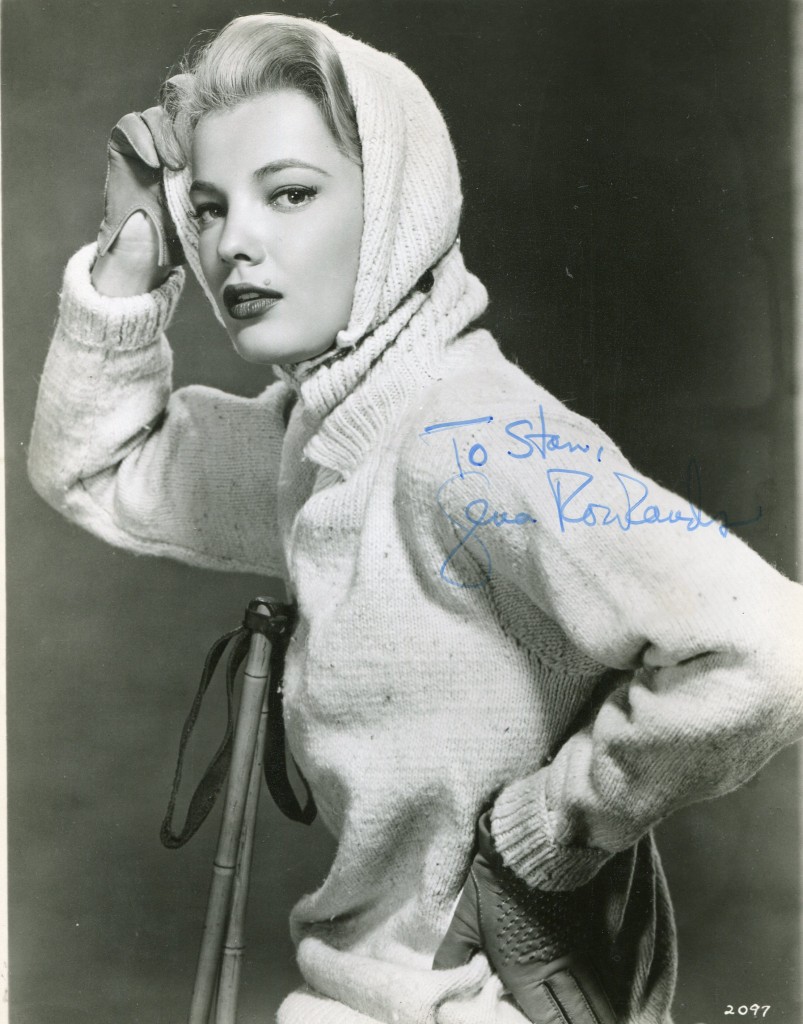

Gena Rowlands was born in 1930 is an American actress, whose career in film, stage, and television has spanned over six decades. A four-time Emmy and two-time Golden Globe winner, she is known for her collaborations with her late actor-director husband John Cassavetes in ten films, including A Woman Under the Influence (1974) and Gloria (1980), which earned her nominations for the Academy Award for Best Actress. She also won the Silver Bear for Best Actress for Opening Night (1977). In November 2015, Rowlands received an Honorary Academy Award in recognition of her unique screen performances.
Rowlands was born on June 19, 1930, in Madison, Wisconsin. Her mother, Mary Allen (Neal), was a housewife who later worked as an actress under the stage name Lady Rowlands.. Her father, Edwin Myrwyn Rowlands, was a banker and state legislator. He was a member of the Wisconsin Progressive Party, and was of Welsh descent. She had a brother, David Rowlands.
Her family moved to Washington, D.C., in 1939, when Edwin was appointed to a position in the United States Department of Agriculture; moved to Milwaukee, Wisconsin, in 1942, when he was appointed as branch manager of the Office of Price Administration; and later moved to Minneapolis, Minnesota. From 1947–50, she attended the University of Wisconsin, where she was a popular student already renowned for her beauty. While in college, she was a member of Kappa Kappa Gamma. She left for New York City to study drama at the American Academy of Dramatic Arts.
In the early 1950s, Rowlands performed with repertory theatre companies and at the Provincetown Playhouse. She made her Broadway debut in The Seven Year Itch and toured in a national production of the play. Rowlands costarred with Paul Stewart in the 26-episode syndicated TV series Top Secret (1954–55), and she guest starred on such anthology television series as Robert Montgomery Presents, Appointment with Adventure, Kraft Television Theatre, and Studio One (1955). In 1956, she starred in Middle of the Night opposite Edward G. Robinson. She appeared alongside her husband John Cassavetes on an episode (“Fly Baby, Fly”) of the 1959–60 NBC detective series Johnny Staccato. She also appeared on an episode of the NBC western series, Riverboat, starring Darren McGavin, and the ABC adventure series, The Islanders, set in the South Pacific. Also in 1959, Rowlands appeared in the Western series Laramie episode titled “Run to Tumavaca”. Rowlands made her film debut in The High Cost of Loving in 1958.
In 1961–62, she starred in David Miller’s “Lonely are the Brave”, with Kirk Douglas and Walter Mathau and Carroll O’Connor. She starred as Jerri Bondi, the wife of Paul Bondi, (Michael Kane) but still deeply caring for ex-lover, cowboy Jack Burns, (Kirk Douglas) in a fantastically moving performance. In that same season, she appeared on ABC‘s Target: The Corruptors!, starring Stephen McNally. She also guest starred in CBS‘s The Lloyd Bridges Show and ABC’s Breaking Point. In 1963, she guest-starred in an episode on the NBC western series, Bonanza, Laramie and The Virginian, and “The Lonely Hours”, “Murder Case” and “Ride The Nightmare” on CBS’s The Alfred Hitchcock Hour. In 1967, she was cast as socialite Adrienne Van Leyden in the prime time ABC soap opera Peyton Place.
Rowlands and Cassavetes made ten films together: A Child Is Waiting (1963), Faces (1968), Machine Gun McCain (1969), Minnie and Moskowitz (1971), A Woman Under the Influence (1974; nomination for Academy Award for Best Actress), Two-Minute Warning (1976), Opening Night (1977), Gloria (1980; nomination for Academy Award for Best Actress), Tempest (1982), and Love Streams (1984).
According to Boston University film scholar Ray Carney, Rowlands sought to suppress an early version of Cassavetes’ first film, Shadows, that Carney says he rediscovered after decades of searching.[12] Rowlands also became involved in the screenings of Husbands and Love Streams, according to Carney. The UCLA Film and Television Archive mounted a restoration of Husbands, as it was pruned down (without Cassavetes’ consent, and in violation of his contract) by Columbia Pictures several months after its release, in an attempt to restore as much of the removed content as possible. At Rowlands’ request, UCLA created an alternative print with almost ten minutes of content edited out, as Rowlands felt that these scenes were in poor taste. The alternative print is the only one that has been made available for rental.
In 1985, Rowlands played the mother in the critically acclaimed made-for-TV movie An Early Frost. She won an Emmy for her portrayal of former First Lady of the United States Betty Ford in the 1987 made-for-TV movie The Betty Ford Story.
In 1988, Rowlands starred in Woody Allen‘s dramatic film Another Woman. She played Marion Post, a middle-aged professor who is prompted to a journey of self-discovery when she overhears the therapy sessions of another woman (Mia Farrow). The review in Time Out described the character’s trajectory: “Marion gets to thinking, and is appalled to realise that so many assumptions about her own life and marriage are largely unfounded: in her desire for a controlled existence, she has evaded the emotional truth about relationships with her best friend (Sandy Dennis), brother (Harris Yulin) and husband (Ian Holm).” Time Out praised the “marvellous” performances in the film, adding, “Rowlands’ perfectly pitched approach to a demanding role is particularly stunning.” Film4 called her performance “sublime”, while Roger Ebert noted that it marked a considerable change in tone from her work with Cassavetes, thus showing “how good an actress Rowlands has been all along.”
In 2002, Rowlands appeared in Mira Nair‘s HBO movie Hysterical Blindness, for which she won her third Emmy. She was later seen in The Notebook (2004), which was directed by her son Nick Cassavetes. The same year, she won her first Daytime Emmy for her role as Mrs. Evelyn Ritchie in The Incredible Mrs. Ritchie. In 2005, she appeared opposite Kate Hudson, Peter Sarsgaard, and John Hurt in the gothic thriller The Skeleton Key.
In 2003, she appeared as Mrs. Hellman in Numb3rs. She played a Nazi survivor whose whole family was killed. The family owned a painting that the Nazis confiscated. Later on the painting reappeared. The new owner lent the painting to an art gallery in Los Angeles but while on display it was stolen. The F.B.I. agent, played by Don Eppes, tries to figure out what really happened. Rowlands received rave reviews for this role. She has been a spokesperson for people who were persecuted by the Nazis so this role was a perfect match for her.
In 2007, she played a supporting role opposite Parker Posey and Melvil Poupaud in Broken English, an independent American feature written and directed by her daughter Zoe Cassavetes. In 2009, she appeared on an episode of Monk (“Mr. Monk and the Lady Next Door”). On March 2, 2010, she appeared on an episode of NCIS as lead character Leroy Jethro Gibbs‘s former mother-in-law, who is embroiled in a murder investigation.[citation needed] In 2014, she starred in the film adaptation of Six Dance Lessons in Six Weeks.
Rowlands was married to John Cassavetes from April 9, 1954, until his death on February 3, 1989. They met at the American Academy at Carnegie Hall where they were both students. They had three children, all actor-directors: Nick, Alexandra, and Zoe. Rowlands married retired businessman Robert Forrest in 2012.
Rowlands has stated that she was a fan of actress Bette Davis while growing up. She played Davis’s daughter in Strangers.
Rowlands has been nominated for two Academy Awards, eight Primetime Emmy Awards, one Daytime Emmy Award, eight Golden Globe Awards, three Satellite Awards, and two SAG Awards. Some of her notable wins are a Silver Bear for Best Actress, three Primetime Emmy Awards and one Daytime Emmy Award, two Golden Globe Awards, two National Board of Review Awards, and two Satellite Awards.
In January 2015, Rowlands was presented with a lifetime achievement award by the Los Angeles Film Critics Association.At the 2015 Governors Awards, she received an Honorary Academy Award. The press release described Rowland as “an original talent” whose “devotion to her craft has earned her worldwide recognition as an independent film icon”.
Guardian obituary in 2024
Gena Rowlands, who has died aged 94, was in the tradition of formidable performers such as Bette Davis and Joan Crawford yet, unlike them, she always remained an actor rather than a star. She was, said the critic Kent Jones, “finally a little too weird for superstardom”.
She did her most fearless work as part of an informal repertory company (also including Peter Falk, Ben Gazzara and Seymour Cassel) in a string of dense, demanding and highly charged films by her husband, the devoutly independent director John Cassavetes, who favoured rawness and improvisation but scorned compromise. The most comparatively gentle of their collaborations was Minnie and Moskowitz (1971), in which she and Cassel gave what the critic Roger Ebert called “performances so beautiful you can hardly believe it” as mismatched lovers.
Their characters were based loosely on Rowlands and Cassavetes themselves, right down to her penchant for wearing sunglasses at night and his dishevelled appearance.
In A Woman Under the Influence (1974), arguably the couple’s joint masterpiece, Rowlands combined scalding intensity with unflinching vulnerability as Mabel, a wife and mother whose mental health is fast degrading, opposite Falk as her uncomprehending husband. Jones described her performance as “an imaginative feat”, characterised by “her abstracted turns of the head and hands, her overemphatic emotional responses, her violent attempts to eradicate potentially threatening impulses”. It earned her the first of two Oscar nominations.
Opening Night (1977) was an extended, Bergman-esque character study of Myrtle, an actor contending simultaneously with the death of a fan, her own fears that she is over-the-hill, and a sudden loss of faith in her own talent. Now highly regarded, it was panned on its initial US release and played to near-empty cinemas, though Rowlands was rewarded for yet another blistering performance with the best actress prize at the Berlin film festival.
In Cassavetes’s most commercial film, Gloria (1980), she was dynamic as a gun-toting former showgirl protecting a young boy from the mob. The role only came her way after Barbra Streisand turned it down on the basis that it was “too maternal” and “not glamorous enough”. But it brought Rowlands a second Oscar nomination and catered perfectly to her knack for lacing tenderness with grit.
It was precisely that combination to which she responded in her screen idol, Marlene Dietrich. “Rowlands was fascinated with Dietrich’s blend of feminine sexual allure and almost masculine toughness and swagger,” wrote Cassavetes’s biographer, Ray Carney, who noted that she even “adopted a few of Dietrich’s gestures and mannerisms” after becoming obsessed with The Blue Angel while working as a cinema usher in 1950.
She was born in Madison, Wisconsin, the daughter of Mary Ellen (nee Neal), an artist and actor, and Edwin Rowlands, a banker and politician, and was something of a sickly child. When her father was appointed, in 1939, to the US department of agriculture, the family moved to Washington DC; they later moved back to Wisconsin, then to Minnesota.
Rowlands studied English at the University of Wisconsin, but her deep desire to become an actor led her to abandon her studies and depart for the American Academy of Dramatic Arts in New York, with her parents’ blessing. It was there that she met Cassavetes, whom she married in 1954. “It was a hard struggle to convince Gena,” he said. “We agree in taste on absolutely nothing.”
As Carney pointed out, he was “the fast-talking, street-smart city boy. Rowlands was socially smooth and refined; Cassavetes rough-hewn, impulsive, passionate and driven. She cared what people thought; he didn’t. She was cool, poised, charming; he was half-crazy, hot-blooded and Mediterranean. Sparks flew.”
She began her career in repertory and summer stock and was spotted in a production at Provincetown Playhouse, Cape Cod (where she also worked as a wardrobe mistress), which led to her being cast as the Mistress of Ceremonies in All About Love at the Versailles Nightclub theatre in New York in 1951. During a period of unemployment, she wrote storylines for the Crime Does Not Pay comic books (“I could tell you what any three-time loser got for assault and battery in any prison in the country”) before first appearing on Broadway as the understudy for the lead in The Seven Year Itch, later taking over the role and touring with it.
She appeared in Dangerous Corner off-Broadway in 1953 and, two years later, was in The Great Gatsby, part of the Robert Montgomery Presents series, on television. After starring opposite Edward G Robinson in Middle of the Night on Broadway in 1956, she signed to MGM and appeared with José Ferrer in her first film, The High Cost of Loving (1958) – although sadly she was not noticed, since it flopped badly (“I think maybe 50 people saw it,” she said).
She insisted that “I wasn’t planning to go into pictures at all,” yet film and television were to take over her career. She played a small, albeit leading, role opposite Kirk Douglas in the fine Lonely Are the Brave (1962), which remained one of her favourites, and was then directed by Cassavetes in A Child Is Waiting (1963). She had made a brief appearance in her husband’s debut, Shadows (1958), an independent production that broke all the rules of film-making.
It was made for a tiny budget with a borrowed camera, with no prospect of being widely shown, yet became a critical and commercial success. Faces (1968), in which Rowlands played a sex worker, equally took the world by storm.
Her performances for Cassavetes are glorious and Rowlands probably never exceeded their power. He directed her in his penultimate film, Love Streams (1984), which reunited her and Cassel, Minnie and Moskovitz themselves, this time as a former couple, now divorced and disillusioned.
The central relationship, though, is between her and Cassavetes, who plays her brother. “Cassavetes and Rowlands, sharing the screen for the last time, edge their performances into tragicomic slapstick,” wrote the critic Dennis Lim. As Jones put it: “Theirs would be one of the cinema’s greatest and most complex on-screen love affairs, if not for the simple fact that it plumbs so much deeper than mere infatuation.”
Their final collaboration came in 1987, two years before Cassavetes’s death from cirrhosis of the liver, when he directed Rowlands and Carol Kane in his play A Woman of Mystery at the Court theatre in Los Angeles. In an otherwise unimpressed review, the LA Times singled out Rowlands, who played a woman going up in the world, as “a strong presence … the feeling is that of a valiant woman who will keep going until she comes to a better place”.
Rowlands made a wealth of other work. She played the mother trying to do right by her children in Paul Schrader’s underrated Light of Day (1987) and the lead in Woody Allen’s Another Woman (1988), which took her away from the more physically extroverted Cassavetes roles. In Allen’s film, in which she portrayed a character who has consistently repressed her emotions, her lovely, shoulder-length blond hair was tied back and darkened. Unfairly, the film was a critical failure and Rowlands’s extraordinary performance was rather overlooked in favour of Gene Hackman’s brief appearances.
Her co-star in Jim Jarmusch’s Night on Earth (1991), Winona Ryder, said that the way Rowlands lit a cigarette was the best argument for smoking that she had ever seen. Rowlands was cast as an ageing smalltime cabaret singer in Terence Davies’s The Neon Bible (1995). She insisted that “I can’t sing, I can’t hit all the notes”, but for Davies that was what made her so moving.
She was directed by her son Nick in Unhook the Stars (1996), co-starring Gérard Depardieu, and also took parts in Nick’s later films She’s So Lovely (1997), which had a screenplay by John Cassavetes, the weepie The Notebook(2004) and the unconventional Yellow (2012).
In 2006, she wrote the screenplay for and appeared in a segment, directed by Depardieu and Frédéric Auburtin, of the omnibus film Paris, Je T’Aime. The story of a couple who meet for drinks the night before they sign their divorce papers, it co-starred Gazzara. In 2007 she had a supporting role in Broken English, written and directed by her daughter Zoe, and in 2008 provided a voice for the animated film Persepolis.
Olive (2011), in which Rowlands played Tess, was the first full-length film shot entirely on a smartphone. In 2014, she and Frank Langella played a couple facing biological weapons attack in Parts Per Billion; and she and Cheyenne Jackson were a teacher and pupil forming a friendship through dance in Six Dance Lessons in Six Weeks.
Throughout her career, Rowlands consistently took roles on television, including in live productions of the 1950s. She appeared in series such as Laramie (1959), Alfred Hitchcock Presents (1960), 87th Precinct (1961-62), The Virginian (1963), Bonanza (1963), Dr Kildare (1964) and then Peyton Place (1967-68), which she considered “really fun. They offered me a real ‘Joan Crawford’ bad lady … I came in and married old Mr Peyton and took all the money. I loved it and did it until my unfortunate demise of falling down the grand staircase.”
Rowlands observed: “You have to hand it to television – strangely enough it takes on much more dangerous subjects than movies.” Her TV films included An Early Frost (1985), in which she played the mother of an Aids victim. She won Emmys for her performances in The Betty Ford Story (1987), as the US first lady; Face of a Stranger (1991); Mira Nair’s Hysterical Blindness (2002), which reunited her with Gazzara; and The Incredible Mrs Ritchie (2003), a somewhat dull affair produced by her son to which she lent characteristic gravitas.
In 2009, she was seen in an episode of the TV series Monk, and in 2010 was in NCIS. Two years later she married Robert Forrest, a former businessman.
In 2015 she was awarded an honorary Oscar. Earlier this year, Nick announced that she had been suffering for some years from Alzheimer’s disease.
Rowlands is survived by her three children, Nick, Zoe and Alexandra.
Gena (Virginia Cathryn) Rowlands, actor, born 19 June 1930; died 14 August 2024
- Liam
- No Comments
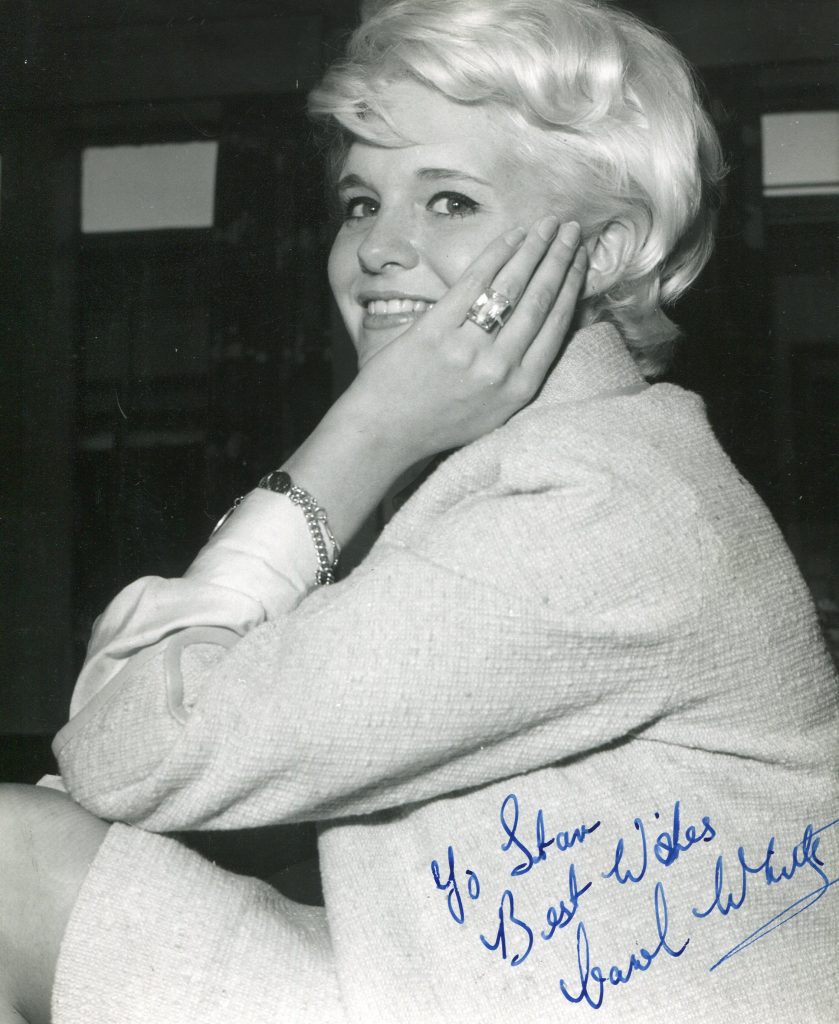
Carol White was one of the gifted young actors who rose to prominence with the rise of British cinema in the 1960’s. She made a huge impact in the television programme “Cathy Come Home” directed by Ken Loach. She went on to work with Loach again in “Poor Cow” opposite Terence Stamp in 1968. The following year she went to Hollywood and made a tense triller “Dayy’s Gone A Hunting” but sadly her career tapered off significantly thereafter. She died in reduced circumstances in 1991 in Miami at the age of 48.
Her obituary from Bob Meade’s website:
CAROL WHITE, the actress who has died in Florida aged 49, was celebrated for her powerful performance in the title role of Cathy Come Home, Jeremy Sandford’s coruscating account of homelessness on BBC Television, which caused a national sensation in the 1960s. Cathy Come Home was not so much a television play as fierce propaganda. Sandford traced the painful downhill journey of a young couple who began their married life full of hope and gaiety and ended it, separated from their children, as casualties of the Welfare State. After an accident cut the husband’s earnings, the couple lived with unfriendly relations, were evicted from squalid tenements, were driven out of a caravan site and found refuge in a rat-ridden hostel. For all its overemphasis, the production showed with compassion the raw degradation of hostel life. In a tour-de-force of naturalistic acting the highly photogenic Carol White succeeded in making Cathy likeable and eventually extremely moving as the courage and optimism in her wasted away. The diminutive Miss White, a London scrap merchant’s daughter who had already made her mark in the television version of Nell Dunn’s Up the Juction (1965), consequently became something of a Sixties icon. She went on to bring warmth and a plausible innocence to the film Poor Cow, a raw and realistic picture of South London life which opened with a graphic scene of Miss White giving birth while reflecting on the shortcomings of her absent husband (“He’s a right bastard”).
Subsequently Miss White was rather miscast as a jolly virginal girl in Michael Winner’s all too forgettable I’ll Never Forget What’s ‘Is Name. However, she made a good impression — when she remembered to substitute a Gloucestershire accent for her native Cockney — as a comely country lass in Dulcima (1971) adapted from a story by H. E. Bates
Miss White showed promise of better things as an actress opposite Alan Bates, Dirk Bogarde and lan Holm in the film of Bernard Malamud’s The Fixer. Her performance as Raisl Bok won her a Hollywood contract in 1968 to make Daddy’s Gone-A-Hunting.
But from then on nothing seemed to go right, and the rest of her career was distinctly chequered. Miss White’s attempts to establish herself in America were dogged by ill fortune. Her name — forever bracketed with her role of Cathy — became more familiar in the press in connection with her amours, divorces, court appearances, drink and drugs than with her acting. “I came to America thinking I was at the very top,” she recalled shortly before her death from liver failure, “and that no one could touch me. But pimps, pushers, liars and ex-husbands brought me crashing down.”-• In 1982 she returned to London to take over the role of Josie from Georgina Hale, in Nell Dunn’s play Steaming, but her comeback ended unhappily when her contract was terminated following several missed performances.
Carol White was born in Hammersmith, London, on April 1 1942. She described her father as “a scrap-metal merchant and a spieler in a fairground and a door-to-door salesman of the elixir of life”. At the age of 11 Carol heard about theatre schools from a hairdresser and thereafter attended the Corona. Miss White made her film debut three years later in Circus Friends and went on to appear in Carry On Teacher, Beat Girl and Never Let Go, in which she played Peter Sellers’s girlfriend. “In those days in British films,” she recalled, “brunettes were ladies and blondes were bits. I wore my hair white and painted my lips red and my eyes dark.” She then married Michael King of the King Brothers singing act and gave up acting for a few years. She returned, this time on the smaller screen in Emergency — Ward 10 and, more notably, as a bright Battersea girl in Nell Dunn’s exhilarating sketch of South London life, Up the Junction. Miss White’s later films for the cinema — not a distinguished collection — included The Man Who Had Power Over Women, Something Big, Made, Some Call It Loving, The Squeeze, The Spaceman and King Arthur and Nutcracker.
She wrote a racy volume of memoirs, Carol Comes Home (1982), in which the Swinging Sixties of purple hearts and Courreges boots gave way to the excesses of Hollywood (“the assault course of a hundred different bedrooms . . . with broken hearts and broken promises left at every corner”), as well as a beauty book, Forever Young. After her divorce from King she married Dr Stuart Lerner, a psychiatrist, and then Michael Arnold, a musician. She had two sons from her first marriage. Jeremy Sandfbrd writes: In her early films Carol captured powerfully the quality of the urban girl-next-door from the less prosperous areas. And in Cathy Come Home she seemed the archetypal young mother, every mother who has ever struggled not to be separated from her children. I last saw her some 10 years ago when she had come over to London and asked me to help her write her autobiography. She had devastating tales to tell about double-dealing Hollywood psychiatrists. Unknown to her, she told me, hers had been paid double her fee by an ex-boyfriend, to “muck her up”. She told me she had come home for good to live the simple life back in Hammersmith, and I never dreamed she would go back to America. She later wrote the book with help from another writer and I have regretted since that it wasn’t me. It seems the classic tale of the pretty but unsophisticated girl who goes to Hollywood. There is no simple moral, though, because Carol, besides being pure and straight, was always reckless, always something of a life gambler.
September 20 1991
The above obituary can also be accessed online here.
Article from Tina Aumont’s Eyes:
Known as the ‘Battersea Bardot’, Carol White used her working class background to enable her to give several natural performances in British dramas, which sometimes mirrored her own turbulent life. Unfortunately, a later problem with alcohol and drug abuse would harm her career, and ultimately end her life.
Born Carole Joan White in Hammersmith, London, on April 1st 1943, Carol studied drama at the Corona Stage Academy. This led to early minor appearances in many of the UK’s best known products at the time. There were ‘blink and you’ll miss it’ parts in ‘Doctor at Sea’(1956), ‘Blue Murder at St. Trinian’s’(1957), ‘Carry on Teacher’, and ‘The 39 Steps’( both 1959). After another dozen or so bits in mainly sexy background roles, Carol’s breakthrough came in Ken Loach’s 1966 social drama ‘Cathy Come Home’, a ground-breaking production, shot as part of ‘The Wednesday Play’ television series. White’s performance was so realistic that for many years afterwards, Carol would quite often be stopped in the streets by people believing her to be Cathy, and offer her money to help her out.
Following ‘Cathy Come Home’, Ken Loach cast Carol as Joy in what would become White’s signature film, the mostly improvised ‘Poor Cow’ (1967). Carol was superb once again as a struggling young mother, married to an abusive criminal (John Bindon). Carol’s final scene where her character gives an interview to camera is astonishingly real and powerful, leaving the viewer with a slight hope of optimism for the much put-upon Joy. The success of ‘Poor Cow’ had everybody knocking on White’s door, with Frank Sinatra and Warren Beatty just two of Carol’s famous new fans.
Travelling to America, White’s Hollywood career got off to an interesting start. Taking the lead role in Mark Robson’s stalker flick ‘Daddy’s Gone A-Hunting’ (1969), the film has gained a cult reputation over the years. A pretty good thriller, it tells the exciting story of a woman who is menaced by the man whose baby she once aborted.
Favourite Movie: The Squeeze
Favourite Performance: Poor Cow
- Liam
- No Comments
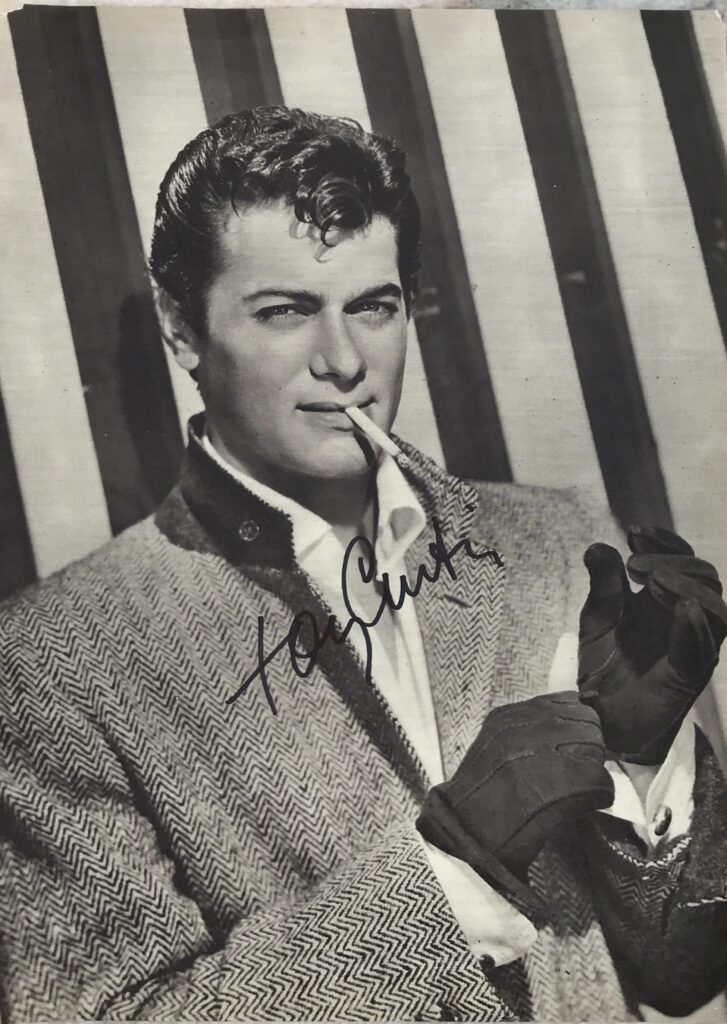

Tony Curtis was born 1925 in New York City. He was one of the giants of Hollywood cinema during the 1950’s and early 1960’s. He was under contract to Universal Studios alongside Rock Hudson and Clint Eastwood. Eastwood took a lot longer to break through into film than Curtis and Hudson. Among Tony Curtis’s many fine films are “Some Like it Hot”, “The Great Race”, “Houdini”, The Vikings”, “The Defiant Ones” and “Taras Bulba”, Tony Curtis died in 2010.
His “Guardian” obituary by Brian Baxter:
Born into a family of Hungarian Jews who had emigrated to the US, Bernard Schwartz – the boy who became the actor Tony Curtis – could scarcely have dreamed of the wealth, fame and rollercoaster life that awaited him. Curtis, who has died aged 85, starred in several of the best films of the 1950s, including Sweet Smell of Success (1957), The Defiant Ones (1958) and Some Like It Hot (1959). He enjoyed a long career thanks to his toughness and resilience (despite insecurities that demanded years of therapy).
He grew up in the Bronx, New York, the eldest of three sons. As a child, he was ill-treated by his mother, Helen, and spent time in an orphanage. One of his brothers, Robert, was a schizophrenic and the other, Julius, was killed in a traffic accident when Tony was 12. At school he became a member of a gang involved in petty crime, but he escaped into the Scouts. He endured poverty and the Depression and, in 1943, joined the US navy, serving as a signalman in the second world war.
He emerged, aged 20, into a world of opportunities – the first being postwar government funding for GIs to train for a career. He decided on acting (his father, Emanuel, had been an actor before becoming a tailor) and entered the Dramatic Workshop in New York. He took the lead in a Greenwich Village revival of Golden Boy, written by Clifford Odets, and was spotted by a studio talent scout and offered a contract by Universal. He first chose Anthony Adverse as his professional name, inspired by the eponymous hero of a novel by Hervey Allen. A casting director persuaded him otherwise, so he kept “Anthony” and added “Curtis”, anglicising a common Hungarian surname.
Like the far grander MGM, or the Rank Organisation’s “charm school” in the UK, Universal had a policy of training promising talent. The prerequisites were good looks and ambition. Curtis had both in abundance. He made his uncredited film debut in Robert Siodmak’s Criss Cross (1949), as a gigolo who dances with Yvonne de Carlo, watched by the male lead, Burt Lancaster, who later played a significant part in Curtis’s career.%
After this 30-second screen exposure, he notched up 10 appearances in two years, including the westerns Sierra and Winchester 73 (both 1950). He later said that the performances were “guided by testosterone, not talent”. He and the other Universal proteges, including Rock Hudson, were trained in acting, fencing, riding and dancing. By 1951 he was considered ready for the lead in a swashbuckler, The Prince Who Was a Thief, and was married to the starlet Janet Leigh, who later appeared alongside him in films including The Vikings (1958).
Curtis went on to star in a slew of second-grade movies, such as Son of Ali Baba (1952) and Houdini (1953). His big break into A-features came when Lancaster chose him as his co-star in Trapeze (1956). They made a convincing pair of high flyers, and the glossy movie, directed by Carol Reed, was an international hit.
After playing the lead in Blake Edwards’s Mister Cory (1957), Curtis joined Lancaster again in Sweet Smell of Success, produced by Lancaster’s company. A superb screenplay, co-written by Odets, was the launchpad for Alexander Mackendrick’s vividly achieved portrait of obsession and betrayal. Lancaster played the reptilian, all-powerful, New York columnist besotted with his sister. Curtis was Sidney Falco, an unprincipled press agent in thrall to (and fear of) the man who could make him king of the jungle, and willing to sell his pride and soul for the title. It gave Curtis the reviews and credibility for which he had yearned.
Routine movies followed until The Defiant Ones gave him his first and only Oscar nomination, for best actor. This modestly liberal story – an archetypal Stanley Kramer film – proved important for Curtis, who insisted that his black co-star Sidney Poitier share top billing. It was significant as a commercially successful film, making a plea for racial tolerance, directed and acted with force and integrity. Although he did not get the Oscar (which went to David Niven for Separate Tables), Curtis was soon to receive a greater prize – the second great movie of his career, Billy Wilder’s Some Like It Hot.
After this movie, Curtis’s career declined in quality, if not quantity. Edwards capitalised on his two best roles and cast him opposite his hero Grant in the bright and funny Operation Petticoat (1959), where he played a jokey variation of Sidney Falco. The following year he was in heady if duller company in Stanley Kubrick’s Spartacus, playing Antoninus, the handsome slave who flees from the overtures of his master, Laurence Olivier.
Appearing alongside Jack Lemmon and – less happily – a difficult Marilyn Monroe, Curtis enjoyed three sublime manifestations in the film. First, as one of two jazz musicians who flee from gangsters after witnessing the St Valentine’s Day massacre in Chicago in 1929. Second, in drag as a member of the all-girl band which provides his camouflage. And last as a fake oil millionaire – out to seduce Marilyn – played as a wonderful homage to Cary Grant. “Marilyn was an enigma,” he later said. “She was very difficult to read. Marilyn and I were lovers in 1949, 1950, 1951 … It was an important relationship for me.”
He then made two films with the director Robert Mulligan – The Rat Race (1960) and The Great Impostor (1961) – and starred in The Outsider (1961) as Ira Hayes, the Native American hero of the battle of Iwo Jima during the second world war. As Curtis’s career progressed, his marriage to Leigh – who had sacrificed her work for him and their children, Jamie Lee and Kelly – began to disintegrate. They divorced in 1962, and the following year he married the actor Christine Kaufmann, with whom he had two daughters, Alexandra and Allegra. He had some success with Jerry Lewis in the comedy Boeing Boeing (1965) and rejoined Edwards on The Great Race (1965), parodying his charismatic persona with a cocky grin and effortless charm
He had less success with Mackendrick’s Don’t Make Waves (1967), a slow-burn comedy which suffered from studio interference. He then made a strenuous effort for critical acclaim with his role as the serial killer Albert DeSalvo in The Boston Strangler (1968), flashily directed with use of a split screen. More routine films, and a lucrative two-year stint in the television series The Persuaders (1971-72), kept him busy, as did his increased interest in his painting, art collecting and writing. He married the model Leslie Allen in 1968 (having divorced Kaufmann the year before) and dedicated his frantic, exhausting novel, Kid Andrew Cody and Julie Sparrow (1977), to her. He had two sons with Allen, Nicholas and Benjamin.
Occasional meaty parts continued to come his way, including the eponymous gangster in Lepke (1975) and the fading, impotent movie star in the lugubrious The Last Tycoon (1976). He returned to the stage in the 1979 Los Angeles run of Neil Simon’s play I Ought to Be in Pictures. His best work on television was in The Scarlett O’Hara War (1980), as the producer David O Selznick, and the series Vega$ (1978-81). But he had lost his comic lightness of touch and decent parts were rare, although he relished his role as the Senator in Nicolas Roeg’s Insignificance (1985). He was admitted to the Betty Ford clinic for treatment for his alcohol and drug abuse, and his other 80s credits, such as Lobster Man from Mars (1989), revealed his diminishing standing.
Curtis and Allen had divorced in 1982, and he married the lawyer Lisa Deutsch in 1993. They divorced the following year. Curtis talked of quitting show business to open an art gallery in Europe. There were also rumours of a return to the stage opposite Lemmon and of a second novel. In the event, he returned to big and small screens in a desire not to earn money but to keep working. His autobiography was published in 1993, and in the mid-90s he suffered personal trauma as he underwent heart surgery and his son Nicholas died of a heroin overdose.
He married Jill VandenBerg, more than 40 years his junior, in 1998, and said he had never been happier. Curtis relished being remembered for the Mackendrick movies above all, and for his quirky cameos (often uncredited) in numerous films – not least as the “voice” in Rosemary’s Baby (1968). But he remained bitter about the lack of official recognition for his best work, convinced that he lost out on an Oscar for The Defiant Ones because of his “pretty boy” image. On the occasions I met him at his London home in Chester Square, Belgravia, he was always interested in showing his work as an artist. His paintings have been exhibited in Europe and the US, at galleries including the Metropolitan Museum in New York.
Curtis is survived by Jill, his daughters Jamie Lee, Kelly and Allegra (who all became actors), another daughter, Alexandra, and his son Benjamin.
• Tony Curtis (Bernard Schwartz), actor, born 3 June 1925; died 29 September
- Liam
- No Comments
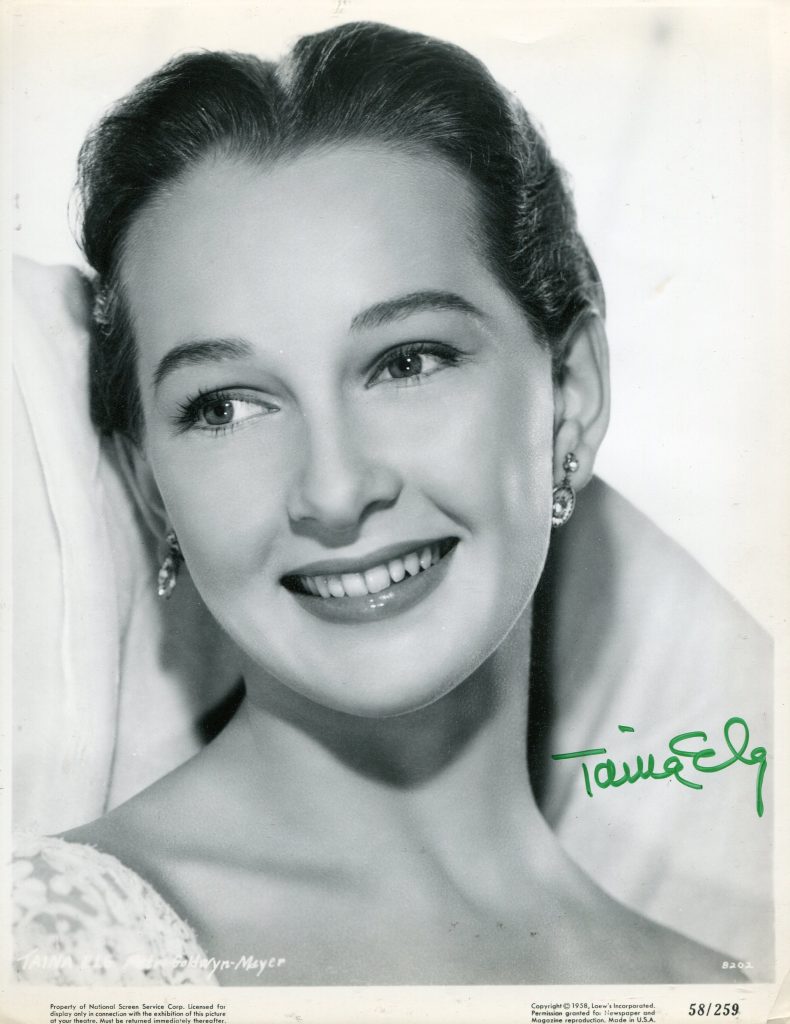
TAINA ELG (WIKIPEDIA)
Taina Elg is one of the few actresses who hail from Finland to star in Hollywood films. She was born in Helsinki in 1930. She trained originally as a ballet dancer. She joined the Sadler Welles Ballet company in London. She was noticed by an American film producer and offered a Hollywood contract. Her first U.S. film was “The Prodigal” with Edmund Purdom and Lana Turner in 1955. She made a number of other films for MGM including “Gaby” and “Diane”. She went on to star with Kay Kendall, Gene Kelly and Mitzi Gaynor in “Les Girls” amusical with songs by Cole Porter. She then went to Britain to film the remake of “The 39 Steps” with Kenneth More. Her film career waned somewhat during the early 1960’s and she acted more frequently on stage and on television. Her son is the famous jazz guitarist Raoul Bjorkenheim. Interview with Taina Elg on “Finland Center” website
The Times obituary:
When Taina Elg first arrived in the United States in 1954, under contract with Metro-Goldwyn-Mayer, the studio launched a newspaper campaign to find a new name for the Finnish ballerina. Readers were offered the chance to win a $25,000 cash prize and a six-room house by sending in more palatable suggestions — along with old labels from corned beef hash and devilled ham (the draw had been sponsored by the meat product company Armour Star). Nothing came of it but as Elg’s career in Hollywood matured, newspapers helpfully continued to point out that her first name rhymed with “Dinah”.
For many years she was, as the Times-Tribune reported, Hollywood’s “only Finn of note”, but in some ways Elg had arrived on the scene too late. Her great talent was as a dancer — a trained ballerina, she had danced with Sadler’s Wells — but when her big break came, in the form of the 1957 Cole Porter musical film Les Girls, big-budget musicals were on the wane.
However ill-timed, Les Girls would ensure Elg a place in the canon and playing Angèle Ducros, one of three cabaret dancers who cattily vie for the attention of their caddish troupe leader, Barry, played by Gene Kelly, was the ideal entrée. Years later the girls get embroiled in a lawsuit, started by the capricious Angèle, after one of them publishes a damning memoir detailing Angèle’s attempted suicide after the end of her affair with Barry
Based on a dancer’s memories of her time in the Folies Bergère in Paris, the musical — a “lively pot-pourri of gossip and slander”, according to The New York Times — gave Elg the chance to sing some of Cole Porter’s best-known songs, including Ca c’est l’amour, which she sings to Kelly in a rowboat, and the burlesque number Ladies in Waiting, which she performed in Louis XV drag.
Les Girls won best picture at the Golden Globes and best actress for Elg, shared with her co-star Kay Kendall, but it marked an end of sorts for many of its troubadours. It was to be Cole Porter’s final film score and the last musical either Kelly or the producer Sol Siegel made. And if Elg thought it her big break, she was to be bitterly disappointed. She left MGM two years later. “When I asked for a release from my contract,” she said, “I think they were as relieved as I was. There were only 14 actors still there full-time. When I’d signed a few years earlier, there had been between 40 and 50.
Taina Elisabeth Elg was born in Helsinki in 1930. Her Russian mother, Helena Doroumova, was a gifted pianist, as was her father, Ake Elg, who died in the Second World War. The family moved to Switzerland then Canada. When they returned to Helsinki after the war, Taina continued to nurture her childhood passion for dancing and singing and was invited to join the Finnish National Ballet. She had been there for six years when she was cast in her first film, about a country girl who moves to town to become a “lady”, has a child with the son of the professor with whom she lodges and becomes a prostitute
For the next few years Elg “fanatically” dedicated herself to ballet and as her international reputation grew, she joined Sadler’s Wells in London and the Grand Ballet du Marquis de Cuevas in Paris. During one performance she was spotted by the American film producer Edwin H Knopf, brother of the publisher Alfred, and in the wake of the success of her fellow Scandinavian Anita Ekberg she was offered a seven-year contract with MGM. At first Elg refused: she was engaged to Carl Björkenheim, who was working in his family’s shipping firm in Finland, and wanted to stay.
A few months later she got a letter from Knopf asking her to reconsider. Her now-husband agreed to go with her. “We thought, why not?” she recalled. “We were young and full of adventurous spirit.” In America the young couple were introduced to the glitterati of Hollywood at “wonderful parties”, including one for MGM’s 30th anniversary in which the newest recruit posed for a photograph with the oldest, Lionel Barrymore. Yet Elg’s experience of Hollywood was far tamer than many. “I can’t tell you any lurid stories because I was never involved in any of them,” she said in a later interview. “I was under contract, I was married, I was very safe at MGM and I had lovely friends. We used to go skiing all the time and we swam and played tennis and did javelin throwing.”
Her debut role was as Elissa in The Prodigal (1955). She had little film experience and was “absolutely mortified to be in this big production with Louis Calhern and Lana Turner and Walter Hampden”, she recalled. “Here I was, left to my own devices. I was really shaking in my shoes but I pretended like I had done it all my life and got a few technical pointers from Edmund [Purdom)
Her most prominent role was that of a schoolteacher in the classic The 39 Steps(1959), based on the John Buchan thriller and co-starring Kenneth Moore. A gifted linguist, she was often cast in foreign roles — as a French cabaret singer in Les Girls, a French farm worker alongside Glenn Ford in Imitation General (1958) and a German missionary’s daughter in the adventure film Watusi (1959) — but by the Sixties her Hollywood career was in decline and she began to focus on television projects, foreign pictures and theatre, appearing in musicals such as Irma La Douce, West Side Story — two years before the film was released — and The Sound of Music. “It’s a pity that I didn’t happen to have been born ten years earlier so I could have had more chances of improving and being in more films,” she said
The rest of her career featured musicals such as Sondheim’s A Little Night Music(1973) and Frank Loesser’s revival of Where’s Charley? (1974), for which she earned a Tony nomination, and film credits including Hercules in New Yorkstarring Arnold Schwarzenegger, Liebestraum and The Mirror has Two Faces, a 1996 rom-com starring Barbra Streisand. Yet playing the understudy to Julie Christie’s Yelena in Uncle Vanya in 1973 seemed to sum up some of the disappointments of her career. “I didn’t get a chance to go on and play it as Julie was in excellent health,” she said.
She divorced Björkenheim not long after arriving in the US. She is survived by their son, Raoul, a jazz guitarist. Her second husband, Rocco Caporale, an Italian professor of sociology, predeceased her in 2008. After his death she left New York and returned to Helsinki, where she enjoyed watching plays and films, though rarely her own.
Despite the occasional twinge of regret, in interviews she appeared gentle and good-humoured. She would know when she had made it, she once said, when people no longer tripped over her name. It is a sad irony that this was often the case.
Taina Elg, actress, was born on March 9, 1930. She died on May 15, 2025, age
Finland’s first (and arguably only) genuine Hollywood movie star, Taina Elg, has died at the age of 95, newspaper Helsingin Sanomat reported on Monday.
Elg died at a nursing home in Helsinki on 15 May, HS said.
The future star was born in Helsinki in 1930 and started her Hollywood career in the 1950s. She studied ballet and first went abroad to find work as a dancer, before an injury cut that career short.
She was then invited to audition as an actor in Hollywood, and ended up signing a seven-year contract with Metro-Goldwyn-Mayer (MGM) studios when she was just over the age of 20. At the time, MGM was one of the most powerful studios in Hollywood.
As the new technology of television was starting to draw audiences away from the cinema, MGM started to make big musicals, and Elg landed her biggest role in one of them.
Released in 1957 and directed by George Cukor, the musical comedy Les Girls starred Gene Kelly, Mitzi Gaynor and Kay Kendall alongside Elg. The legendary Cole Porter was behind the film’s music and lyrics
The film won an Academy Award for best costume design and was also nominated in two other categories.
Elg won a Golden Globe award for that film, and also won a Golden Globe in the ‘Female Foreign Newcomer’ category in 1957 for her work in the film Gaby.
In an interview in the early 1990s, Elg told Yle how she became friends with Hollywood stars like Elizabeth Taylor and Lana Turner, saying the latter taught her a lot about acting on the big screen.
Elg’s Hollywood success made her a superstar back home, and her visits to Finland became major media events in the 1950s
After a career in Hollywood that lasted until the end of the 1950s, Elg moved to New York City. There, in the 1960s, she appeared in Broadway musicals and also had a starring role in the western TV series Wagon Train.
Her career in theatre, film and television continued until the 1990s
The Guardian obituary in 2025.
Asked how she would know when she had hit the big time, the beguiling actor Taina Elg, who has died aged 95, said: “When people no longer trip over my name.”
When she arrived in the US in 1954 at the start of her contract with MGM, a newspaper campaign engineered by the studio and sponsored by Armour Star meat products offered readers the chance to win a six-room house or $25,000 cash by proposing a new name for this latest exotic star-in-the-making. Contestants were asked to send in suggested names along with labels from corned beef hash and devilled ham. This all came to nought, and she was still not-so-plain-old Taina Elg when she began appearing on screen.
She landed her first major US role in 1957 (the same year that the Golden Globes named her New Foreign Star of the Year) in the Gene Kelly musical Les Girls. Newspapers were still helpfully reminding their readers at every opportunity that her first name rhymed with “Dinah”. They were also prone to tell them, as the Times-Tribune did in 1958, that Elg was “the only Finn of note” at that time in Hollywood and “the first from her country to become a genuine star of cinema
In Les Girls, directed by George Cukor and with music by Cole Porter, Elg held her own alongside Mitzi Gaynor and Kay Kendall as dancers in a cabaret troupe headed by Kelly. Based on Constance Tomkinson’s reminiscences of her time in the Folies Bergère, and showing each character in succession looking back on the troupe’s glory days before acrimony set in, the film’s use of contradictory perspectives made it the closest thing to a musical take on Kurosawa’s Rashomon. Elg’s performance as the apparently lovelorn and suicidal member of the group won her a second Golden Globe.
She followed this with Imitation General (1958), in which she was a French farm worker involved with a master sergeant (played by Glenn Ford) who impersonates a dead general to keep up his platoon’s morale. The role was played entirely in French.
I’m the only Finnish actress working here,” Elg said the following year. “Yet of the six films I’ve made, I have portrayed a French girl four times.”
Watusi (1959), in which she was a missionary’s daughter rescued by explorers and caught up in their jungle adventures, took the unfashionable route of making her German.
In the same year, she starred in the second adaptation of John Buchan’s The 39 Steps (and the first in colour) as the netball coach who ends up handcuffed to the hero, here played by Kenneth More, as he is pursued by assassins.
Elg was born in Helsinki, and raised in assorted other Finnish locations, including Turku, by her mother, Helena Doroumova, and father, Åke Elg, who were both pianists. During the Finnish-Soviet wars, the family were forced to leave, returning to Helsinki only after the end of the second world war.
Taina trained as a ballet dancer from an early age and was accepted by the Finnish National Ballet as a child, which led to a handful of small roles in domestic films. She also danced at Sadler’s Wells and at the Grand Ballet du Marquis de Cuevas in Paris and the Ballet Russe de Monte Carlo, before an injury led her to reconsider her career.
She was spotted in London by the producer Edwin H Knopf, brother of the publisher Alfred. After an impressive screen test directed by Mel Ferrer, she was signed to a seven-year contract with MGM in Hollywood. Small roles followed in two films starring Lana Turner – the biblical tale The Prodigal (1955), in which Elg played a slave, and the 16th-century romance Diane (1956) – as well as Gaby (also 1956), with Leslie Caron as a French ballet dancer
The career high-point of Les Girls was never equalled. For the remainder of her career, Elg worked mostly in television and theatre. Occasional exceptions included Hercules in New York (1970), which gave an early starring role to the young Arnold Schwarzenegger.
In 1962, she headed the national touring production of Irma La Douce. In 1973, she starred on Broadway in Look to the Lilies, as well as understudying Julie Christie as Yelena in a production of Uncle Vanya. “I didn’t get a chance to go on and play it, as Julie was in excellent health,” she said.
In 1982, she originated the role of the philandering hero’s mother in Nine, the Broadway musical based on Fellini’s 8½. Her son was played by Raul Julía, with whom she had also starred in the 1974 revival of Where’s Charley?, for which she earned a Tony nomination.
She briefly found her way back to cinema thanks to two directors with a taste for the power of nostalgia. Mike Figgis’s thriller Liebestraum (1991), which was also Kim Novak’s final film before retiring, gave Elg her first movie role in more than two decades, as the matriarch of a department store business. She was a teacher in the romantic comedy The Mirror Has Two Faces (1996), starring and directed by Barbra Streisand. Her final screen role came in the Finnish caper Kummelin Jackpot (2006).
Elg is survived by her son, the jazz guitarist Raoul Björkenheim, from a five-year marriage to Carl Gustav Björkenheim, which ended in divorce in 1958. Her second marriage, to Rocco Caporale, an academic, ended with his death in 2008.
- Liam
- No Comments
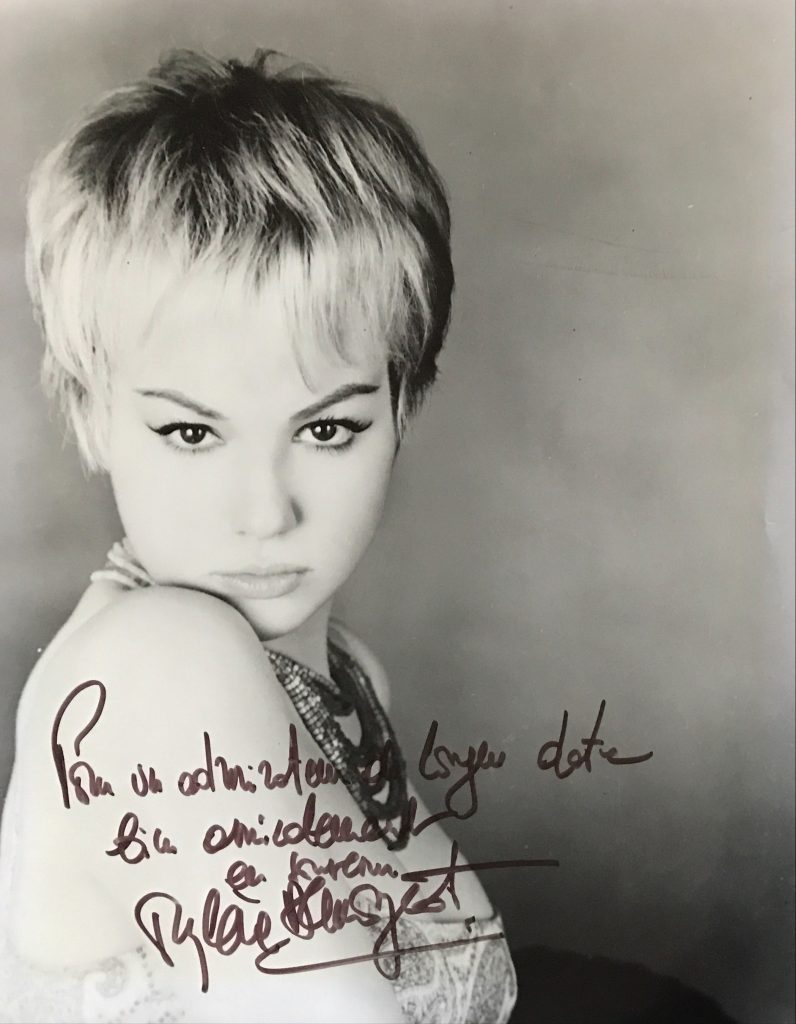
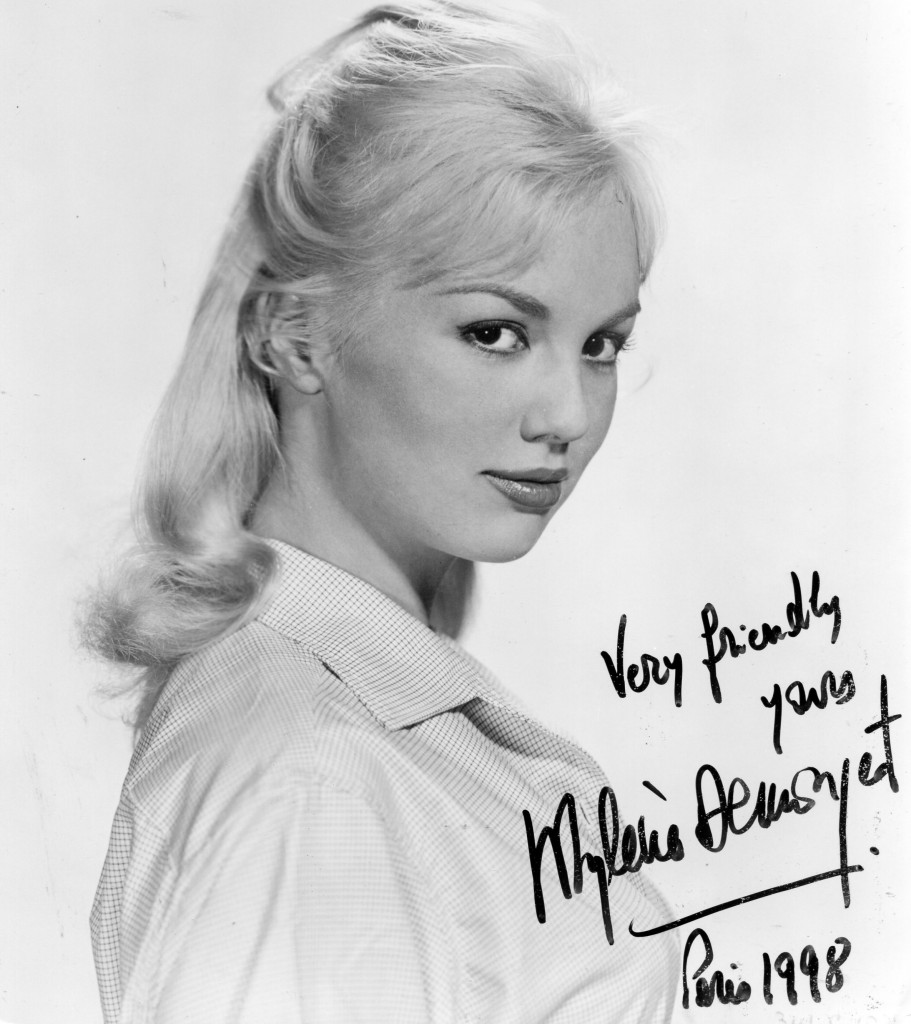
EYE FOR FILM OBITUARY IN 2022:
One of the last surviving French sex symbols from the Fifties and Sixties Mylène Demongeot has died at the age of 87 after a long illness.
Demongeot who spent her youth in Montpellier and adored the region around the town, latterly had devoted herself to animal rights in common with her contemporary Brigitte Bardot. Bardot wrote in one of her books that “Mylène was my little cinema sister, then became my combat sister, a libra like me, she has always loved animals”.
After the death of her long-standing companion Didier Raoult, the actress had her own battles with cancer and recently coronavirus against which she had declined to be vaccinated, claiming to have multiple allergies.
Despite more than her fair share of adversity she kept working and recently appeared in such popular box office hits as Retirement Home (Maison de Retraite) by Thomas Gilou, playing opposite Gérard Depardieu; Camping 3 by Fabien Onteniente with Claude Brasseur, and The Midwife (Sage Femme by Martin Provost) with Catherine Frot and Catherine Deneuve.
The daughter of a French father and Ukrainian mother the actress made an early impression in Raymond Rouleau’s production of The Witches Of Salem alongside Simone Signoret and Yves Montand.
She was taken up and promoted by photographer Henri Coste with whom she learned to pose for the camera and who later became her first husband.
Demongeot was born in Nice in 1935 and appeared in more than 72 films in a career which spanned six decades. She was nominated for a Bafta award as most promising newcomer in 1957 for a Franco-German production of The Crucible, and was praised by the play’s author Arthur Miller as “bursting with real sexuality”.
She performed in such costume adventures as The Vengeance Of The Three Musketeers (1961) as Milady de Winter and in comedies, among them Fantômas (1964), directed by André Hunebelle, and its various sequels.
On the international arena notably she co-starred with David Niven in Otto Preminger’s Bonjour Tristesse from the novel by Françoise Sagan (1958). In the UK she co-starred in several comedies, including It’s A Wonderful World (1956); Upstairs and Downstairs (1959) and Doctor in Distress (1963).
Demongeot was also nominated for César Awards for Best Supporting Actress in 36 Quai des Orfèvres (2004) and La Californie . Her husband was Marc Simenon, the son of Maigret creator Georges Simenon..
In her later years she was conned out of her life-savings of some two million euros after a financial scare and only had survived by making drastic economies and living in a small flat in Paris. The anti-corruption squad eventually caught the culprit.
- Liam
- No Comments
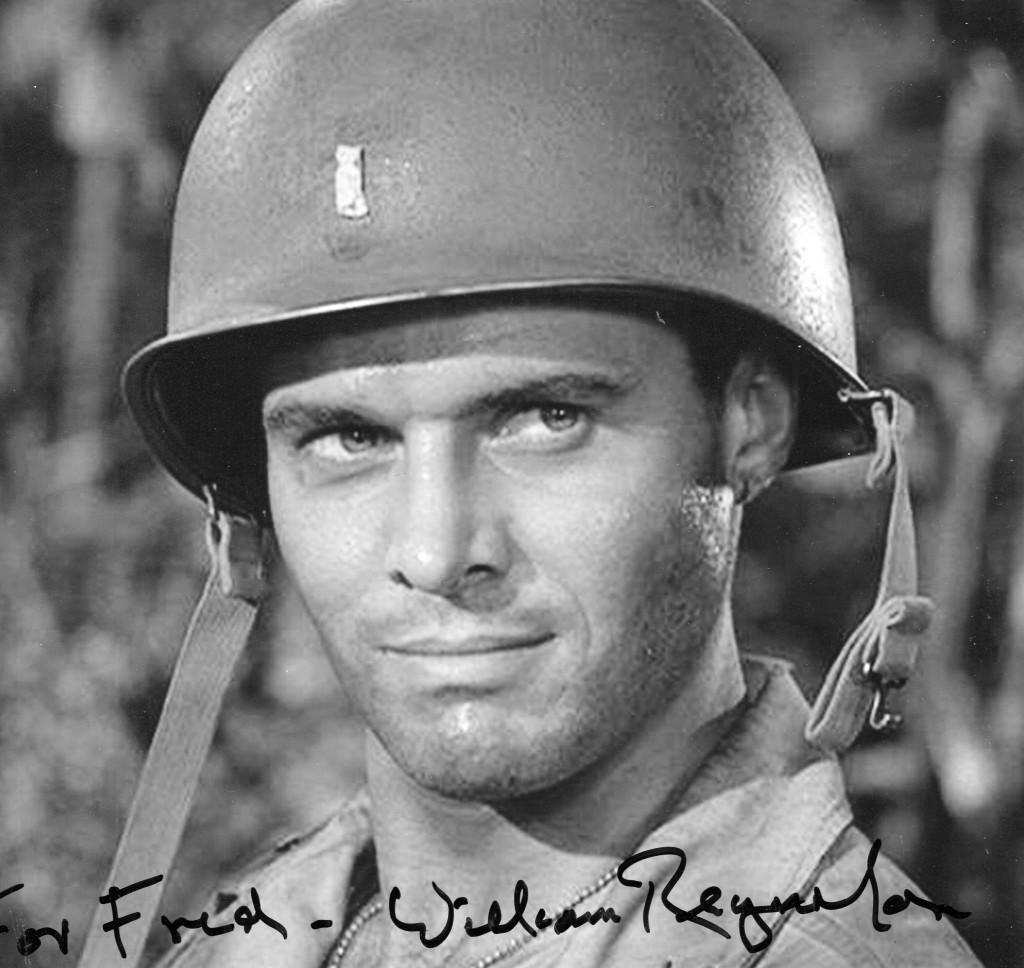
William Reynolds, who portrayed Special Agent Tom Colby for six seasons on the television series The F.B.I., died August 24 from non-Covid pneumonia complications, his son Eric Regnolds confirms. He was 90.
Born William de Clercq Regnolds on December 9, 1931, in Los Angeles, he began his career under contract to Universal Pictures and had credits in Carrie (1952), as Laurence Olivier’s son, and The Son of Ali Baba, where he was Tony Curtis’ best friend. For 20th Century Fox, he portrayed Rommel’s son opposite James Mason in The Desert Fox
Following his military service in Japan during the Korean War, Reynolds co-starred in Cult of the Cobra (1955). In 1959, he starred as trumpeter Pete Kelly in the television series Pete Kelly’s Blues. In 1960-1961, he starred as air charter entrepreneur and adventurer Sandy Wade on the The Islanders, while also appearing as a World War II officer in Rod Serling’s acclaimed Twilight Zoneepisode “The Purple Testament”.
Other film credits include The Battle at Apache Pass, Francis Goes to West Point, The Mississippi Gambler, Gunsmoke, There’s Always Tomorrow, Away All Boatsand The Land Unknown. Television work included roles in Bronco, Wagon Train, The Roaring 20s, Cheyenne, Dragnet and Maverick.
After making guest appearances on the first two seasons of The FBI, Reynolds won the big break of his career, taking on the part of stalwart and heroic Agent Colby, opposite Efrem Zimbalist’s Inspector Erskine, for six seasons on the hit ABC series.
Reynolds quit Hollywood after his role on The F.B.I. and became a businessman. He was married for 42 years to actress Molly Sinclair, until her passing in 1992. The couple had two children, Carrie Regnolds Jones (Brian Jones) and Eric Regnolds (Nikki Camello), two grandchildren, Anthony Regnolds Jones and Nicholas Camello Regnolds, and one great grandchild, Gianni Camello Regnolds.
- Liam
- No Comments
Sites of Interest
These are some of my favourite film websites. They are a fantastic resource for any film buff.
